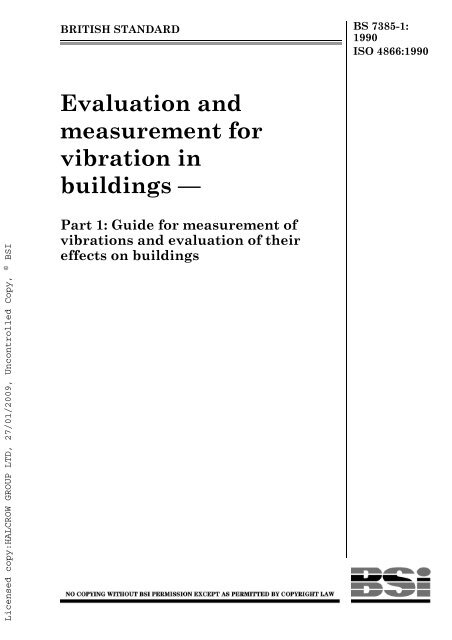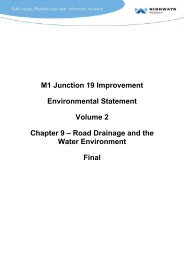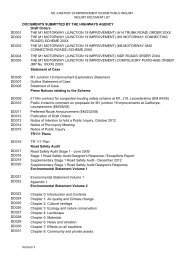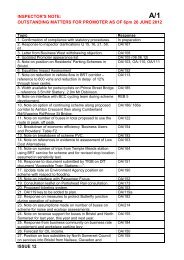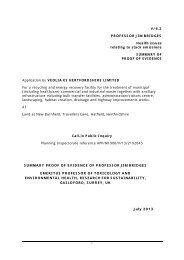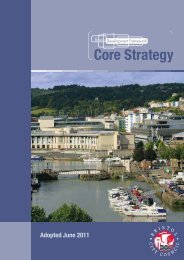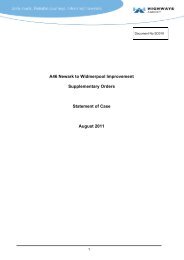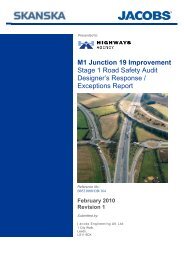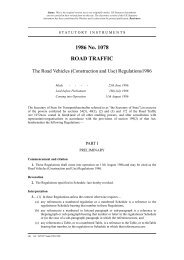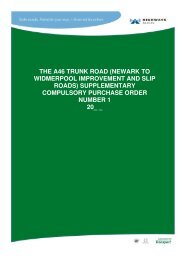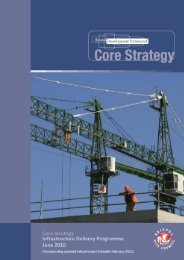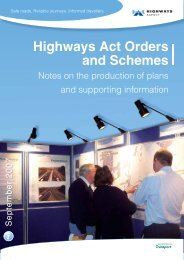Evaluation and Measurement for Vibration in Buildings Part 1, BSI ...
Evaluation and Measurement for Vibration in Buildings Part 1, BSI ...
Evaluation and Measurement for Vibration in Buildings Part 1, BSI ...
Create successful ePaper yourself
Turn your PDF publications into a flip-book with our unique Google optimized e-Paper software.
BRITISH STANDARD BS 7385-1:<br />
1990<br />
ISO 4866:1990<br />
<strong>Evaluation</strong> <strong>and</strong><br />
measurement <strong>for</strong><br />
vibration <strong>in</strong><br />
build<strong>in</strong>gs —<br />
Licensed copy:HALCROW GROUP LTD, 27/01/2009, Uncontrolled Copy, © <strong>BSI</strong><br />
<strong>Part</strong> 1: Guide <strong>for</strong> measurement of<br />
vibrations <strong>and</strong> evaluation of their<br />
effects on build<strong>in</strong>gs
BS 7385-1:1990<br />
Committees responsible <strong>for</strong> this<br />
British St<strong>and</strong>ard<br />
Licensed copy:HALCROW GROUP LTD, 27/01/2009, Uncontrolled Copy, © <strong>BSI</strong><br />
This British St<strong>and</strong>ard, hav<strong>in</strong>g<br />
been prepared under the<br />
direction of the General<br />
Mechanical Eng<strong>in</strong>eer<strong>in</strong>g<br />
St<strong>and</strong>ards Policy Committee,<br />
was published under the<br />
authority of the Board of <strong>BSI</strong><br />
<strong>and</strong> comes <strong>in</strong>to effect on<br />
30 November 1990<br />
© <strong>BSI</strong> 01-1999<br />
The follow<strong>in</strong>g <strong>BSI</strong> references<br />
relate to the work on this<br />
st<strong>and</strong>ard:<br />
Committee reference GME/21<br />
Draft <strong>for</strong> comment 86/75451 DC<br />
ISBN 0 580 19097 8<br />
The preparation of this British St<strong>and</strong>ard was entrusted by the General<br />
Mechanical Eng<strong>in</strong>eer<strong>in</strong>g St<strong>and</strong>ards Policy Committee (GME/-) to Technical<br />
Committee GME/21, upon which the follow<strong>in</strong>g bodies were represented:<br />
Department of Trade <strong>and</strong> Industry (National Eng<strong>in</strong>eer<strong>in</strong>g Laboratory)<br />
Electricity Supply Industry <strong>in</strong> Engl<strong>and</strong> <strong>and</strong> Wales<br />
Eng<strong>in</strong>eer<strong>in</strong>g Equipment <strong>and</strong> Materials Users’ Association<br />
Institute of Sound <strong>and</strong> <strong>Vibration</strong> Research<br />
Institution of Mechanical Eng<strong>in</strong>eers<br />
Lloyds Register of Shipp<strong>in</strong>g<br />
M<strong>in</strong>istry of Defence<br />
Power Generation Contractors Association (BEAMA Ltd.)<br />
Society of British Aerospace Companies Ltd.<br />
Society of Environmental Eng<strong>in</strong>eers<br />
Society of Motor Manufacturers <strong>and</strong> Traders Limited<br />
The follow<strong>in</strong>g bodies were also represented <strong>in</strong> the draft<strong>in</strong>g of the st<strong>and</strong>ard,<br />
through subcommittees <strong>and</strong> panels:<br />
British Aggregate Construction Materials Industries<br />
British Coal Corporation<br />
British Compressed Air Society<br />
British Railways Board<br />
Federation of Civil Eng<strong>in</strong>eer<strong>in</strong>g Contractors<br />
Institute of Explosives Eng<strong>in</strong>eers<br />
Institution of Civil Eng<strong>in</strong>eers<br />
National Federation of Demolition Contractors<br />
Amendments issued s<strong>in</strong>ce publication<br />
Amd. No. Date Comments
BS 7385-1:1990<br />
Contents<br />
Licensed copy:HALCROW GROUP LTD, 27/01/2009, Uncontrolled Copy, © <strong>BSI</strong><br />
Page<br />
Committees responsible<br />
Inside front cover<br />
National <strong>for</strong>eword<br />
ii<br />
Introduction 1<br />
1 Scope 1<br />
2 Normative references 2<br />
3 Source-related factors to be considered 2<br />
4 Build<strong>in</strong>g-related factors to be considered 2<br />
5 Quantity to be measured 3<br />
6 Measur<strong>in</strong>g <strong>in</strong>strumentation 3<br />
7 Position <strong>and</strong> fix<strong>in</strong>g of transducers 5<br />
8 Data collection, reduction <strong>and</strong> analysis 7<br />
9 Method of data evaluation 7<br />
Annex A (<strong>in</strong><strong>for</strong>mative) Classification of build<strong>in</strong>gs 12<br />
Annex B (<strong>in</strong><strong>for</strong>mative) Estimation of peak stress from peak particle velocity 16<br />
Annex C (<strong>in</strong><strong>for</strong>mative) R<strong>and</strong>om data 16<br />
Annex D (<strong>in</strong><strong>for</strong>mative) Bibliography 18<br />
Figure 1 — Categories of the types of data 8<br />
Table 1 — Typical range of structural response <strong>for</strong> various sources 5<br />
Table A.1 — Categorization of structures accord<strong>in</strong>g to<br />
group of build<strong>in</strong>g 14<br />
Table A.2 — Classification of build<strong>in</strong>gs accord<strong>in</strong>g to their<br />
resistance to vibration <strong>and</strong> the tolerance that can be accepted<br />
<strong>for</strong> vibrational effects 15<br />
Publication(s) referred to<br />
Inside back cover<br />
© <strong>BSI</strong> 01-1999 i
BS 7385-1:1990<br />
National <strong>for</strong>eword<br />
This <strong>Part</strong> of BS 7385 has been prepared under the direction of the General<br />
Mechanical Eng<strong>in</strong>eer<strong>in</strong>g St<strong>and</strong>ards Policy Committee. It is identical with<br />
ISO 4866:1990 “Mechanical vibration <strong>and</strong> shock — <strong>Vibration</strong> of build<strong>in</strong>gs —<br />
Guidel<strong>in</strong>es <strong>for</strong> the measurement of vibrations <strong>and</strong> evaluation of their effects on<br />
build<strong>in</strong>gs”, which was prepared by Technical Committee ISO/TC108, Mechanical<br />
vibration <strong>and</strong> shock, of the International Organization <strong>for</strong> St<strong>and</strong>ardization (ISO)<br />
<strong>and</strong> <strong>in</strong> the development of which the United K<strong>in</strong>gdom played an active part.<br />
Cross-references<br />
International st<strong>and</strong>ard<br />
ISO 5348:1987<br />
IEC 68-2-27:1987<br />
Correspond<strong>in</strong>g British St<strong>and</strong>ard<br />
BS 7129:1989 Recommendations <strong>for</strong> mechanical<br />
mount<strong>in</strong>g of accelerometers <strong>for</strong> measur<strong>in</strong>g mechanical<br />
vibration <strong>and</strong> shock<br />
(Identical)<br />
BS 2011 Environmental test<strong>in</strong>g<br />
<strong>Part</strong> 2.1 Ea:1988 Test Ea. Shock<br />
(Identical)<br />
Licensed copy:HALCROW GROUP LTD, 27/01/2009, Uncontrolled Copy, © <strong>BSI</strong><br />
The Technical Committee has reviewed the provisions of ISO 2041, ISO 2631-2<br />
<strong>and</strong> ISO 4356, to which reference is made <strong>in</strong> the text, <strong>and</strong> has decided that they<br />
are acceptable <strong>for</strong> use <strong>in</strong> conjunction with this st<strong>and</strong>ard. A related British<br />
St<strong>and</strong>ard to ISO 2041 is BS 3015:1976 “Glossary of terms relat<strong>in</strong>g to mechanical<br />
vibration <strong>and</strong> shock”.<br />
A British St<strong>and</strong>ard does not purport to <strong>in</strong>clude all the necessary provisions of a<br />
contract. Users of British St<strong>and</strong>ards are responsible <strong>for</strong> their correct application.<br />
Compliance with a British St<strong>and</strong>ard does not of itself confer immunity<br />
from legal obligations.<br />
Summary of pages<br />
This document comprises a front cover, an <strong>in</strong>side front cover, pages i <strong>and</strong> ii,<br />
pages 1 to 18, an <strong>in</strong>side back cover <strong>and</strong> a back cover.<br />
This st<strong>and</strong>ard has been updated (see copyright date) <strong>and</strong> may have had<br />
amendments <strong>in</strong>corporated. This will be <strong>in</strong>dicated <strong>in</strong> the amendment table on the<br />
<strong>in</strong>side front cover.<br />
ii<br />
© <strong>BSI</strong> 01-1999
ISO 4866:1990(E)<br />
Licensed copy:HALCROW GROUP LTD, 27/01/2009, Uncontrolled Copy, © <strong>BSI</strong><br />
Introduction<br />
It is <strong>in</strong>creas<strong>in</strong>gly recognized that build<strong>in</strong>gs must<br />
susta<strong>in</strong> vibrations, <strong>and</strong> recognition of this is needed<br />
both <strong>in</strong> design <strong>for</strong> structural <strong>in</strong>tegrity, serviceability<br />
<strong>and</strong> environmental acceptability, <strong>and</strong> <strong>in</strong> the<br />
preservation of historic build<strong>in</strong>gs.<br />
<strong>Measurement</strong> of vibration <strong>in</strong> a build<strong>in</strong>g is carried<br />
out <strong>for</strong> a variety of purposes:<br />
— Problem recognition<br />
Where it is reported that a build<strong>in</strong>g is<br />
vibrat<strong>in</strong>g at such a level as to cause concern to<br />
occupants, it may be necessary to establish<br />
whether or not the levels warrant concern <strong>for</strong><br />
structural <strong>in</strong>tegrity.<br />
— Control monitor<strong>in</strong>g<br />
Where maximum permitted vibration levels<br />
have been established by some agency <strong>and</strong><br />
those vibrations have to be measured <strong>and</strong><br />
reported.<br />
— Documentation<br />
Where dynamic load<strong>in</strong>g has been recognized<br />
<strong>in</strong> design <strong>and</strong> measurements are made to<br />
verify the predictions of response <strong>and</strong> provide<br />
new design parameters. These may use<br />
ambient or imposed load<strong>in</strong>g. Strong motion<br />
seismographs, <strong>for</strong> example, may be <strong>in</strong>stalled<br />
so as to <strong>in</strong>dicate whether or not the responses<br />
to earthquake warrant changes on operat<strong>in</strong>g<br />
procedure <strong>in</strong> a structure.<br />
— Diagnosis<br />
Where it has been established that vibration<br />
levels require further <strong>in</strong>vestigation,<br />
measurements are made <strong>in</strong> order to provide<br />
<strong>in</strong><strong>for</strong>mation <strong>for</strong> mitigation procedures.<br />
Another diagnostic procedure is to use<br />
structural response to ambient or imposed<br />
load<strong>in</strong>g to establish structural condition, <strong>for</strong><br />
example, after a severe load<strong>in</strong>g, such as an<br />
earthquake.<br />
Such diverse purposes call <strong>for</strong> a variety of<br />
measur<strong>in</strong>g systems rang<strong>in</strong>g from the simple to the<br />
sophisticated, deployed <strong>in</strong> different types of<br />
<strong>in</strong>vestigation (see 9.2).<br />
Technical guidance is needed by many <strong>in</strong>terested<br />
parties on the most appropriate ways of measur<strong>in</strong>g,<br />
characteriz<strong>in</strong>g <strong>and</strong> evaluat<strong>in</strong>g those vibrations that<br />
affect build<strong>in</strong>gs. This applies both to build<strong>in</strong>gs<br />
already <strong>in</strong> existence, which may be subjected to<br />
some new or changed source of excitation, <strong>and</strong> to the<br />
design of build<strong>in</strong>gs to be erected <strong>in</strong> an environment<br />
where the build<strong>in</strong>g may be excited significantly.<br />
The effects of vibration may also be taken <strong>in</strong>to<br />
account by calculation (see 9.1).<br />
Although the material <strong>in</strong> this International<br />
St<strong>and</strong>ard may be used <strong>in</strong> apprais<strong>in</strong>g the relative<br />
severity of structural vibration, it is not to be<br />
regarded as suggest<strong>in</strong>g acceptable or non-acceptable<br />
levels. Nor does it consider economic <strong>and</strong> social<br />
aspects, which would be dealt with, as appropriate,<br />
by national regulatory bodies.<br />
1 Scope<br />
This International St<strong>and</strong>ard establishes the basic<br />
pr<strong>in</strong>ciples <strong>for</strong> carry<strong>in</strong>g out vibration measurement<br />
<strong>and</strong> process<strong>in</strong>g data, with regard to evaluat<strong>in</strong>g<br />
vibration effects on build<strong>in</strong>gs. It does not cover the<br />
source of excitation except <strong>in</strong>sofar as the source<br />
dictates dynamic range, frequency or other<br />
parameters. The evaluation of the effects of build<strong>in</strong>g<br />
vibration is primarily directed at structural<br />
response, <strong>and</strong> <strong>in</strong>cludes appropriate analytical<br />
methods where the frequency, duration <strong>and</strong><br />
amplitude can be def<strong>in</strong>ed. This International<br />
St<strong>and</strong>ard only deals with the measurement of<br />
structural vibration <strong>and</strong> excludes the measurement<br />
of airborne sound pressure <strong>and</strong> other pressure<br />
fluctuations although response to such excitations is<br />
taken <strong>in</strong>to consideration.<br />
A build<strong>in</strong>g, <strong>for</strong> the purposes of this International<br />
St<strong>and</strong>ard, is def<strong>in</strong>ed as any above-ground structure,<br />
which man frequently <strong>in</strong>habits. This excludes from<br />
consideration certa<strong>in</strong> items of plant, <strong>for</strong> example<br />
columns, stacks, headframe, conta<strong>in</strong>ments, even<br />
though they may receive <strong>in</strong>termittent visits from<br />
operat<strong>in</strong>g staff.<br />
The structural response of build<strong>in</strong>gs depends upon<br />
the excitation; to this end this International<br />
St<strong>and</strong>ard exam<strong>in</strong>es the methods of measurements<br />
as affected by the source, i.e. frequency, duration,<br />
<strong>and</strong> amplitudes as <strong>in</strong>duced by any source, such as<br />
earthquakes, explosions, w<strong>in</strong>d effects, sonic booms,<br />
<strong>in</strong>ternal mach<strong>in</strong>ery, traffic, construction activities<br />
<strong>and</strong> others.<br />
NOTE 1 There are differences between earthquakes <strong>and</strong><br />
man-made vibrations which affect record<strong>in</strong>g conditions.<br />
Earthquake-fault-rupture sources are large <strong>in</strong> size <strong>and</strong> much<br />
deeper than most man-made sources. They can cause damage at<br />
great distances, have much greater energy flux <strong>and</strong> duration <strong>and</strong><br />
a different pattern of wave propagation. Consequently, <strong>for</strong> the<br />
same parameter value (<strong>for</strong> example peak particle velocity), the<br />
effects on build<strong>in</strong>gs are different.<br />
© <strong>BSI</strong> 01-1999 1
ISO 4866:1990(E)<br />
Licensed copy:HALCROW GROUP LTD, 27/01/2009, Uncontrolled Copy, © <strong>BSI</strong><br />
2 Normative references<br />
The follow<strong>in</strong>g st<strong>and</strong>ards conta<strong>in</strong> provisions which,<br />
through reference <strong>in</strong> this text, constitute provisions<br />
of this International St<strong>and</strong>ard. At the time of<br />
publication, the editions <strong>in</strong>dicated were valid. All<br />
st<strong>and</strong>ards are subject to revision, <strong>and</strong> parties to<br />
agreements based on this International St<strong>and</strong>ard<br />
are encouraged to <strong>in</strong>vestigate the possibility of<br />
apply<strong>in</strong>g the most recent editions of the st<strong>and</strong>ards<br />
<strong>in</strong>dicated below. Members of IEC <strong>and</strong> ISO ma<strong>in</strong>ta<strong>in</strong><br />
registers of currently valid International St<strong>and</strong>ards.<br />
ISO 2041:1975, <strong>Vibration</strong> <strong>and</strong> shock—Vocabulary.<br />
ISO 2631-2:1989, <strong>Evaluation</strong> of human exposure to<br />
whole-body vibration — <strong>Part</strong> 2: Cont<strong>in</strong>uous <strong>and</strong><br />
shock-<strong>in</strong>duced vibrations <strong>in</strong> build<strong>in</strong>gs (1 to 80 Hz).<br />
ISO 4356:1977, Bases <strong>for</strong> the design of structures —<br />
De<strong>for</strong>mations of build<strong>in</strong>gs at the serviceability limit<br />
states.<br />
ISO 5348:1987, Mechanical vibration <strong>and</strong> shock —<br />
Mechanical mount<strong>in</strong>g of accelerometers.<br />
IEC 68-2-27:1987, Environmental test<strong>in</strong>g —<br />
<strong>Part</strong> 2: Tests — Test Ea <strong>and</strong> Guidance: Shock.<br />
3 Source-related factors to be<br />
considered<br />
3.1 Characteristics of vibration responses <strong>in</strong><br />
build<strong>in</strong>gs<br />
The types of vibration can be classified as<br />
a) determ<strong>in</strong>istic,<br />
b) r<strong>and</strong>om,<br />
<strong>and</strong> further subdivided as given <strong>in</strong> 8.2.<br />
For each type of vibration, a m<strong>in</strong>imum amount of<br />
<strong>in</strong><strong>for</strong>mation is needed so that adequate def<strong>in</strong>ition of<br />
the type of vibration can be drawn up<br />
(see ISO 2041).[1]<br />
3.2 Duration<br />
The duration of the dynamic excit<strong>in</strong>g <strong>for</strong>ce is an<br />
important parameter. For the purposes of this<br />
International St<strong>and</strong>ard, the response can be<br />
regarded as cont<strong>in</strong>uous or transient, <strong>and</strong> the type of<br />
response will be dictated by the relationship<br />
between the time constants associated with the<br />
structural response <strong>and</strong> the <strong>for</strong>c<strong>in</strong>g function.<br />
The time constant of a resonance response <strong>for</strong><br />
resonance, r, <strong>in</strong> seconds, τ r , is given by<br />
where<br />
j r<br />
represents the <strong>in</strong>fluence of the damp<strong>in</strong>g <strong>and</strong><br />
depends on the k<strong>in</strong>d of excitation (l<strong>in</strong>ear or<br />
non-l<strong>in</strong>ear);<br />
Two cases can thus be def<strong>in</strong>ed (without regard to<br />
whether or not the excitation is determ<strong>in</strong>istic or<br />
r<strong>and</strong>om):<br />
— Cont<strong>in</strong>uous<br />
If the <strong>for</strong>c<strong>in</strong>g function imp<strong>in</strong>ges on the<br />
structure cont<strong>in</strong>uously <strong>for</strong> more than 5τ r , then<br />
the vibration is regarded as cont<strong>in</strong>uous.<br />
— Transient<br />
If the <strong>for</strong>c<strong>in</strong>g function exists <strong>for</strong> a time which<br />
is less than 5τ r , then the response is regarded<br />
as transient.<br />
S<strong>in</strong>ce <strong>for</strong>c<strong>in</strong>g functions which occur naturally are<br />
often not well behaved it may be that responses do<br />
not fall easily <strong>in</strong>to a s<strong>in</strong>gle category. For example<br />
blast<strong>in</strong>g even with several <strong>in</strong>tervals would be<br />
considered transient.<br />
3.3 Frequency <strong>and</strong> range of vibration <strong>in</strong>tensity<br />
The frequency range of vibrations of <strong>in</strong>terest<br />
depends upon the distribution of spectral content<br />
over the frequency range of the excitation <strong>and</strong> upon<br />
the mechanical response of the build<strong>in</strong>g. This<br />
p<strong>in</strong>po<strong>in</strong>ts the spectral content as a most important<br />
property of vibration <strong>in</strong>put. For simplicity’s sake,<br />
this International St<strong>and</strong>ard deals with frequencies<br />
rang<strong>in</strong>g from 0,1 Hz to 500 Hz; it covers the<br />
response of build<strong>in</strong>gs of a wide variety <strong>and</strong> build<strong>in</strong>g<br />
elements to excitation from natural (w<strong>in</strong>d <strong>and</strong><br />
earthquake) <strong>and</strong> to man-made (construction,<br />
blast<strong>in</strong>g, traffic) causes. Internal mach<strong>in</strong>ery may<br />
require higher frequencies to be recorded.<br />
Most build<strong>in</strong>g damage from man-made sources<br />
occurs <strong>in</strong> the frequency range from 1 Hz to 150 Hz.<br />
Natural sources, such as earthquakes, usually<br />
conta<strong>in</strong> energy at lower frequencies <strong>in</strong> the range<br />
from 0,1 Hz to 30 Hz at damag<strong>in</strong>g <strong>in</strong>tensities. W<strong>in</strong>d<br />
excitation tends to have significant energy <strong>in</strong> the<br />
frequency range from 0,1 Hz to 2 Hz.<br />
<strong>Vibration</strong> levels of <strong>in</strong>terest range from a few to<br />
several hundred millimetres per second depend<strong>in</strong>g<br />
on frequency.<br />
4 Build<strong>in</strong>g-related factors to be<br />
considered<br />
The reaction of build<strong>in</strong>gs <strong>and</strong> build<strong>in</strong>g components<br />
to dynamic excitation depends upon response<br />
characteristics (<strong>for</strong> example natural frequencies,<br />
mode shapes <strong>and</strong> modal damp<strong>in</strong>g) as well as the<br />
spectral content of the excitation. Cumulative<br />
effects should be considered, especially at high<br />
response level <strong>and</strong> long exposure times where<br />
fatigue damage is a possibility.<br />
2<br />
© <strong>BSI</strong> 01-1999<br />
ƒ r<br />
is the resonance frequency.
ISO 4866:1990(E)<br />
Licensed copy:HALCROW GROUP LTD, 27/01/2009, Uncontrolled Copy, © <strong>BSI</strong><br />
4.1 Type <strong>and</strong> condition of build<strong>in</strong>gs<br />
In order to describe properly <strong>and</strong> categorize the<br />
visible effects of vibration <strong>and</strong> the results of<br />
<strong>in</strong>strumental measurements, a classification of<br />
build<strong>in</strong>gs as def<strong>in</strong>ed <strong>in</strong> clause 1 is needed. For the<br />
purposes of this International St<strong>and</strong>ard, a<br />
classification of build<strong>in</strong>gs is set out <strong>in</strong> annex A.<br />
4.2 Natural frequencies <strong>and</strong> damp<strong>in</strong>g<br />
The fundamental natural frequencies of a build<strong>in</strong>g<br />
or of parts of the build<strong>in</strong>g <strong>in</strong>fluence its response <strong>and</strong><br />
need to be known to allow the several methods of<br />
evaluat<strong>in</strong>g vibration to be applied. This may be<br />
achieved by spectral analysis of low-level response<br />
to ambient excitation or by the use of exciters.[2]<br />
Where a full response analysis is not undertaken<br />
<strong>and</strong> an assessment of potential vibration severity is<br />
needed, empirical expressions relat<strong>in</strong>g the height of<br />
a build<strong>in</strong>g to the fundamental period can be<br />
used.[3], [4], [5]<br />
Experimental studies[6] have <strong>in</strong>dicated the range of<br />
fundamental shear frequency of low-rise<br />
build<strong>in</strong>gs 3m to 12 m high to be from 4 Hz to 15 Hz.<br />
Damp<strong>in</strong>g behaviour is generally<br />
amplitude-dependent. The natural frequency <strong>and</strong><br />
damp<strong>in</strong>g behaviour of stationary structures will be<br />
dealt with <strong>in</strong> a future addendum to this<br />
International St<strong>and</strong>ard.<br />
4.3 Build<strong>in</strong>g base dimensions<br />
Ground-borne vibrations may have wavelengths of a<br />
few metres to several hundreds of metres. The<br />
response excitation from shorter wavelengths is<br />
complex <strong>and</strong> the foundations may act as a filter.<br />
Smaller domestic build<strong>in</strong>gs would generally have<br />
base dimensions smaller than the characteristic<br />
wavelengths of all but the highest-frequency<br />
sources (<strong>for</strong> example precision blast<strong>in</strong>g <strong>in</strong> rock).<br />
4.4 Influence of soil<br />
It is now common <strong>in</strong> earthquake eng<strong>in</strong>eer<strong>in</strong>g studies<br />
to take <strong>in</strong>to account the <strong>in</strong>fluence of the soil.[3]<br />
An evaluation of such <strong>in</strong>teraction effects is<br />
sometimes justified <strong>for</strong> man-made vibrations; such<br />
an evaluation dem<strong>and</strong>s that the shear wave velocity<br />
or dynamic rigidity modulus <strong>in</strong> an appropriate<br />
volume of ground material be determ<strong>in</strong>ed.<br />
Empirical, numerical <strong>and</strong> analytical procedures<br />
may be obta<strong>in</strong>ed from several sources.[7]<br />
1)<br />
Soil compaction may be monitored by precise levell<strong>in</strong>g.<br />
Foundations on poor soils <strong>and</strong> fill may suffer from<br />
settlement or loss of bear<strong>in</strong>g capacity due to ground<br />
vibration. The risk of such effects is a function of the<br />
particle size of the soil, its uni<strong>for</strong>mity, compaction 1) ,<br />
degree of saturation, <strong>in</strong>ternal stress state, as well as<br />
the peak multiaxial acceleration <strong>and</strong> duration of the<br />
ground vibration. Loose, cohesionless, saturated<br />
s<strong>and</strong>s are especially vulnerable <strong>and</strong> <strong>in</strong> extreme<br />
circumstances may undergo liquefaction. This<br />
phenomenon needs to be taken <strong>in</strong>to consideration <strong>in</strong><br />
evaluat<strong>in</strong>g vibrations <strong>and</strong> expla<strong>in</strong><strong>in</strong>g their<br />
effects. [8], [9] (See also annex A.)<br />
5 Quantity to be measured<br />
The characterization of both the nature of vibration<br />
<strong>in</strong>put <strong>and</strong> the response may be effected by a variety<br />
of displacement, velocity or acceleration<br />
transducers. These can furnish a record as a<br />
function of time. It is the usual practice to sense a<br />
k<strong>in</strong>ematic quantity, such as velocity or acceleration.<br />
From knowledge of the appropriate transfer<br />
function of the sens<strong>in</strong>g system, each quantity can be<br />
derived from another by <strong>in</strong>tegration or<br />
differentiation. Integration at lower frequencies<br />
calls <strong>for</strong> care <strong>and</strong> confidence <strong>in</strong> amplitude-phase<br />
response of the transducer <strong>and</strong> <strong>in</strong>strument cha<strong>in</strong><br />
(see clause 6). As long as the requirement on data<br />
collection, treatment <strong>and</strong> presentation (see clause 6)<br />
can be met, the sensor may respond to any chosen<br />
quantity. Experience suggests that there are<br />
preferred measur<strong>in</strong>g quantities <strong>for</strong> different<br />
situations (see Table 1)<br />
6 Measur<strong>in</strong>g <strong>in</strong>strumentation<br />
6.1 General requirements<br />
<strong>Vibration</strong> is measured with a view to us<strong>in</strong>g the data<br />
<strong>in</strong> some evaluatory or diagnostic procedure or to<br />
monitor<strong>in</strong>g a vibration with some established target<br />
level <strong>in</strong> m<strong>in</strong>d. For evaluation, the m<strong>in</strong>imum<br />
per<strong>for</strong>mance shall be sufficient to meet the<br />
requirements laid down <strong>in</strong> clause 3 <strong>and</strong> clause 7<br />
with regard to the evaluatory procedures described<br />
<strong>in</strong> clause 9.<br />
It is not expected that a s<strong>in</strong>gle <strong>in</strong>strumentation<br />
system would meet all the requirements of<br />
frequency <strong>and</strong> dynamic range <strong>for</strong> the wide range of<br />
structures <strong>and</strong> <strong>in</strong>puts <strong>for</strong> which this International<br />
St<strong>and</strong>ard is applicable.<br />
The measur<strong>in</strong>g system <strong>in</strong>cludes the follow<strong>in</strong>g<br />
<strong>in</strong>strumentation:<br />
— transducers (see 6.2);<br />
— signal-condition<strong>in</strong>g equipment;<br />
— data record<strong>in</strong>g system.<br />
© <strong>BSI</strong> 01-1999 3
ISO 4866:1990(E)<br />
Licensed copy:HALCROW GROUP LTD, 27/01/2009, Uncontrolled Copy, © <strong>BSI</strong><br />
The frequency response characteristics (amplitude<br />
<strong>and</strong> phase) need to be specified <strong>for</strong> the complete<br />
measur<strong>in</strong>g system when connected together <strong>in</strong> the<br />
manner to be used.<br />
The degree to which measured motion needs to<br />
approach true motion will depend upon the<br />
character of the <strong>in</strong>vestigation <strong>and</strong> the evaluation<br />
method used.<br />
The m<strong>in</strong>imum requirement <strong>for</strong> 9.2.2 <strong>and</strong> 9.2.3 is<br />
that the vibration shall be characterized by a<br />
cont<strong>in</strong>uous measurement of the peak particle<br />
velocity values.<br />
The m<strong>in</strong>imum requirement <strong>for</strong> 9.2.4 is that the time<br />
history of the vibration shall be recorded over<br />
sufficient duration <strong>and</strong> with sufficient accuracy to<br />
establish its spectral characteristics. Analog or<br />
digital methods are available subject to the<br />
stipulations laid down <strong>in</strong> this clause.<br />
6.2 Choice of transducers<br />
The choice of transducers is important <strong>for</strong> the<br />
correct evaluation of vibratory motion. In general,<br />
transducers may be divided <strong>in</strong>to two groups<br />
produc<strong>in</strong>g a l<strong>in</strong>ear output either above or below the<br />
natural resonance of the sens<strong>in</strong>g mechanism. The<br />
so-called “velocity pick-up” or “geophone” widely<br />
used <strong>in</strong> structural vibration measurement is typical<br />
of an electromagnetic sensor operat<strong>in</strong>g at a<br />
frequency above its natural resonance; whereas a<br />
piezo-electric accelerometer usually operates below<br />
the resonance. There are electromagnetic sensors<br />
which operate below their natural frequency, such<br />
as are widely used strong-motion seismographs.<br />
In practice, care should be exercised <strong>in</strong> us<strong>in</strong>g the<br />
phase <strong>in</strong><strong>for</strong>mation from the “velocity pick-up” type<br />
of transducer at the lower frequencies. If both<br />
amplitude <strong>and</strong> phase response are critical, l<strong>in</strong>ear<br />
per<strong>for</strong>mance of the whole measur<strong>in</strong>g cha<strong>in</strong> should<br />
be ensured. A low-frequency cut-off ten times the<br />
lowest required measured frequency is often<br />
recommended as a good compromise <strong>and</strong>, <strong>in</strong> general,<br />
the measured signal should be 5dB above the<br />
back-ground noise.<br />
Velocity pick-ups generate a relatively high signal<br />
thus simplify<strong>in</strong>g the <strong>in</strong>strument cha<strong>in</strong>. If particle<br />
velocity is needed, the piezo-electric accelerometer<br />
output needs <strong>in</strong>tegrat<strong>in</strong>g, <strong>and</strong> with transients the<br />
response of the whole cha<strong>in</strong> should be verified.<br />
6.3 Signal-to-noise ratio<br />
The signal-to-noise ratio should generally be not<br />
less than 5db.If the signal-to-noise ratio is<br />
between 10 dB <strong>and</strong> 5dB, the measured value<br />
should be corrected (i.e. dim<strong>in</strong>ished) <strong>and</strong> the<br />
correction method reported. Background noise is<br />
def<strong>in</strong>ed as the sum of all the signals not due to the<br />
phenomenon under <strong>in</strong>vestigation.<br />
4<br />
© <strong>BSI</strong> 01-1999
ISO 4866:1990(E)<br />
Licensed copy:HALCROW GROUP LTD, 27/01/2009, Uncontrolled Copy, © <strong>BSI</strong><br />
<strong>Vibration</strong> <strong>for</strong>c<strong>in</strong>g function<br />
Table 1 — Typical range of structural response <strong>for</strong> various sources<br />
7 Position <strong>and</strong> fix<strong>in</strong>g of transducers<br />
7.1 Positions<br />
7.1.1 General<br />
Frequency<br />
range<br />
Amplitude<br />
range<br />
The proper characterization of the vibration of a<br />
build<strong>in</strong>g requires a number of positions of<br />
measurement which depend upon the size <strong>and</strong><br />
complexity of the build<strong>in</strong>g.<br />
Where the purpose is to monitor with regard to<br />
imposed vibration, the preferred position is at the<br />
foundation, a typical location be<strong>in</strong>g at a po<strong>in</strong>t low on<br />
the ma<strong>in</strong> load-bear<strong>in</strong>g external wall at ground floor<br />
level when measurements on the foundations<br />
proper are not possible.<br />
<strong>Part</strong>icle<br />
velocity<br />
range<br />
<strong>Part</strong>icle<br />
acceleration<br />
range<br />
Hz µm mm/s m/s 2<br />
Time<br />
characteristic<br />
Measur<strong>in</strong>g<br />
quantities<br />
Traffic<br />
1 to 80 1 to 200 0,2 to 50 0,02 to 1 C/T pvth<br />
road, rail, ground-borne<br />
Blast<strong>in</strong>g vibration 1 to 300 100 to 2500 0,2 to 500 0,02 to 50 T pvth<br />
ground-borne<br />
Pile driv<strong>in</strong>g<br />
1 to 100 10 to 50 0,2 to 50 0,02 to 2 T pvth<br />
ground-borne<br />
Mach<strong>in</strong>ery outside 1 to 300 10 to 1000 0,2 to 50 0,02 to 1 C/T pvth/ath<br />
ground-borne<br />
Acoustic<br />
10 to 250 1 to 1100 0,2 to 30 0,02 to 1 C pvth/ath<br />
traffic, mach<strong>in</strong>ery outside<br />
Air over pressure 1 to 40 T pvth<br />
Mach<strong>in</strong>ery <strong>in</strong>side 1 to 1000 1 to 100 0,2 to 30 0,02 to 1 C/T pvth/ath<br />
Human activities<br />
a) impact 0,1 to 100 100 to 500 0,2 to 20 0,02 to 5<br />
b) direct 0,1 to 12 100 to 5000 0,2 to 5 0,02 to 0,2<br />
T<br />
pvth/ath<br />
Earthquakes 0,1 to 30 10 to 10 5 0,2 to 400 0,02 to 20 T pvth/ath<br />
W<strong>in</strong>d 0,1 to 10 10 to 10 5 T ath<br />
Acoustic <strong>in</strong>side 5 to 500<br />
Key<br />
C = cont<strong>in</strong>uous<br />
T = transient<br />
⎬ ⎫<br />
⎭<br />
pvth = particle velocity time history<br />
ath = acceleration time history<br />
(simplified categories, see 3.1 <strong>and</strong> 3.2)<br />
NOTE 1 The ranges quoted are extremes but <strong>in</strong>dicate the values which may be experienced <strong>and</strong> which may have to be measured<br />
(see also note 3). Extreme ranges of amplitude of displacement <strong>and</strong> frequency have not been used to derive particle velocity <strong>and</strong><br />
acceleration.<br />
NOTE 2 The frequency range quoted refers to the response of build<strong>in</strong>gs <strong>and</strong> build<strong>in</strong>g elements to the particular type of excitation.<br />
It is <strong>in</strong>dicative only.<br />
NOTE 3 <strong>Vibration</strong> values with<strong>in</strong> the ranges given may cause concern. There are no st<strong>and</strong>ards which cover all varieties of build<strong>in</strong>g,<br />
condition <strong>and</strong> duration of exposure, but many national codes associate the threshold of visible effects with peak particle velocities at<br />
the foundation of a build<strong>in</strong>g of more than a few millimetres per second. A significant probability of some damage is l<strong>in</strong>ked to peak<br />
particle velocities of several hundred millimetres per second. <strong>Vibration</strong> levels below the threshold of human perception<br />
(see ISO 2631-2) may be of concern <strong>in</strong> delicate <strong>and</strong> <strong>in</strong>dustrial processes.<br />
<strong>Measurement</strong>s of vibration response generated by<br />
traffic, pile-driv<strong>in</strong>g <strong>and</strong> blast<strong>in</strong>g, especially at a<br />
great distance, show that the vibration may be<br />
amplified with<strong>in</strong> the build<strong>in</strong>g <strong>and</strong> <strong>in</strong> proportion to<br />
the height of the build<strong>in</strong>g. It may, there<strong>for</strong>e, be<br />
necessary to carry out simultaneous measurements<br />
at several po<strong>in</strong>ts with<strong>in</strong> the build<strong>in</strong>g. Simultaneous<br />
measurements on the foundation <strong>and</strong> the ground<br />
outside will serve to establish a transfer function.<br />
Where a build<strong>in</strong>g is higher than 4 floors ( ≈ 12 m),<br />
subsequent measur<strong>in</strong>g po<strong>in</strong>ts should be added<br />
every 4floors <strong>and</strong> at the highest floor of the<br />
build<strong>in</strong>g.<br />
© <strong>BSI</strong> 01-1999 5
ISO 4866:1990(E)<br />
Licensed copy:HALCROW GROUP LTD, 27/01/2009, Uncontrolled Copy, © <strong>BSI</strong><br />
Where a build<strong>in</strong>g is more than 10 m long, measur<strong>in</strong>g<br />
positions should be <strong>in</strong>stalled at horizontal <strong>in</strong>tervals<br />
of approximately 10 m.<br />
Additional measur<strong>in</strong>g po<strong>in</strong>ts may have to be made<br />
<strong>in</strong> response to requests by occupants <strong>and</strong> as a<br />
consequence of <strong>in</strong>itial observations.<br />
For <strong>in</strong>vestigations of the analytical type, position<strong>in</strong>g<br />
will depend upon the modes of de<strong>for</strong>mation to be<br />
considered. Most practical cases are economically<br />
limited to identification of fundamental modes <strong>and</strong><br />
measurement of maximum responses <strong>in</strong> the whole<br />
structure together with observations on elements<br />
such as floors, walls <strong>and</strong> w<strong>in</strong>dows.<br />
7.1.2 <strong>Measurement</strong> <strong>in</strong> a build<strong>in</strong>g<br />
Transducer placement <strong>in</strong> a build<strong>in</strong>g depends on the<br />
vibration response of concern. As described <strong>in</strong> 7.1.1,<br />
assessment of the vibration be<strong>in</strong>g <strong>in</strong>put to a build<strong>in</strong>g<br />
from ground-borne sources is best done by<br />
measurements on or near the foundation.<br />
Determ<strong>in</strong>ation of structural rack<strong>in</strong>g or of shear<br />
de<strong>for</strong>mation of the build<strong>in</strong>g as a whole requires<br />
measurements directly on the load-bear<strong>in</strong>g<br />
members which af<strong>for</strong>d the structures’ stiffness. This<br />
usually means three components of measurement <strong>in</strong><br />
corners, although other arrangements are possible.<br />
Sometimes, floor or wall motions are of concern,<br />
with maximum amplitudes at mid-span locations.<br />
Although sometimes very severe, these vibrations<br />
are usually unrelated to structural <strong>in</strong>tegrity.[11]<br />
Investigations associated with sources with<strong>in</strong> a<br />
build<strong>in</strong>g usually <strong>in</strong>volve a trial-<strong>and</strong>-error<br />
exploratory phase.<br />
In cases where measurements related to equipment<br />
are to be made, such as when monitor<strong>in</strong>g computers,<br />
relays <strong>and</strong> other <strong>in</strong>stallations sensitive to vibration,<br />
the measurement should reflect the <strong>in</strong>com<strong>in</strong>g<br />
vibration. The po<strong>in</strong>t of measurement should be<br />
placed on or at the foundation or on the frame of the<br />
equipment. In this case, the equipment should if<br />
possible be switched off <strong>for</strong> the measurement.<br />
In cases where measurements related to<br />
ground-transmitted vibration are to be made, such<br />
as where ground vibration sources are be<strong>in</strong>g<br />
studied, it is usual to orientate the sensors with<br />
respect to radial direction def<strong>in</strong>ed as the l<strong>in</strong>e jo<strong>in</strong><strong>in</strong>g<br />
the source <strong>and</strong> the sensor. When study<strong>in</strong>g<br />
structural response to ground vibration, it is more<br />
realistic to orientate with respect to the major <strong>and</strong><br />
m<strong>in</strong>or axes of the structure. It is often not possible<br />
to make measurements at the foundation proper so<br />
<strong>in</strong>struments have to be coupled to the ground.<br />
<strong>Vibration</strong> measurements made on or below the<br />
ground surface may be affected by the variation of<br />
the amplitude of a surface wave with the depth.<br />
Build<strong>in</strong>g foundations may then be exposed to a<br />
motion which is different from the one observed on<br />
the ground surface depend<strong>in</strong>g on the wavelength,<br />
foundation depths <strong>and</strong> geotechnical conditions.<br />
For w<strong>in</strong>d-<strong>in</strong>duced vibration, vertical components<br />
are often dispensed with <strong>and</strong> test <strong>in</strong>strument<br />
disposition should be made with rotational <strong>and</strong><br />
translational modes <strong>in</strong> m<strong>in</strong>d.<br />
7.2 Fix<strong>in</strong>g of transducers<br />
7.2.1 Coupl<strong>in</strong>g to structural elements<br />
The mount<strong>in</strong>g of vibration transducers to vibrat<strong>in</strong>g<br />
elements or substrate should comply with ISO 5348<br />
with regard to accelerometers. The aim should be to<br />
reproduce faithfully the motion of the element or<br />
substrate without <strong>in</strong>troduc<strong>in</strong>g additional response.<br />
Care should be taken with triaxial assemblies to<br />
avoid rock<strong>in</strong>g or bend<strong>in</strong>g.<br />
The mass of the transducer <strong>and</strong> monitor<strong>in</strong>g unit (if<br />
any) shall not be greater than 10 % of the build<strong>in</strong>g<br />
element to which it is fixed. Mount<strong>in</strong>g shall be as<br />
stiff <strong>and</strong> as light as possible.<br />
Brackets should be avoided. It is better to fix three<br />
uniaxial transducers to three faces of a metal cube<br />
rigidly mounted by means of studs or quick-sett<strong>in</strong>g,<br />
high modulus res<strong>in</strong>. The transducer mount<strong>in</strong>g can<br />
be secured to the frame of the build<strong>in</strong>g by expansion<br />
bolts. Gypsum jo<strong>in</strong>ts are preferred when measur<strong>in</strong>g<br />
on lightweight concrete elements.<br />
In special circumstances, it is acceptable to glue the<br />
transducer or attach it us<strong>in</strong>g magnetic attraction.<br />
For measurements <strong>in</strong>doors on horizontal surfaces,<br />
double-sided adhesive tape may be used on all hard<br />
surfaces <strong>for</strong> accelerations below 1m/s 2 , although<br />
mechanical fix<strong>in</strong>gs are preferred.<br />
<strong>Measurement</strong>s on floors hav<strong>in</strong>g compliant cover<strong>in</strong>gs<br />
tend to give distorted results <strong>and</strong> should be avoided.<br />
Where it is not possible to relocate the transducers,<br />
comparative measurements with different mass <strong>and</strong><br />
coupl<strong>in</strong>g conditions <strong>for</strong> the mount<strong>in</strong>g block should<br />
be made to evaluate the effect of the compliant<br />
cover<strong>in</strong>gs.<br />
6<br />
© <strong>BSI</strong> 01-1999
ISO 4866:1990(E)<br />
Licensed copy:HALCROW GROUP LTD, 27/01/2009, Uncontrolled Copy, © <strong>BSI</strong><br />
7.2.2 Coupl<strong>in</strong>g to the ground<br />
Soil conditions permitt<strong>in</strong>g, the transducer may be<br />
fixed to a stiff steel rod (hav<strong>in</strong>g a diameter of not less<br />
than 10 mm), driven through a loose surface layer.<br />
This rod should not project more than a few<br />
millimetres above ground surface. Care should be<br />
taken to ensure close contact between the<br />
transducer <strong>and</strong> the ground. In cases where<br />
acceleration greater than 2m/s 2 is expected, a firm<br />
ground mount<strong>in</strong>g is needed to prevent slippage.<br />
Where transducers have to be mounted <strong>in</strong> the<br />
ground <strong>in</strong> order to m<strong>in</strong>imize coupl<strong>in</strong>g distortion,<br />
they should be buried.<br />
Where transducers have to be mounted <strong>in</strong> the<br />
ground, <strong>in</strong> order to m<strong>in</strong>imize coupl<strong>in</strong>g distortion,<br />
they should be buried to a depth at least three times<br />
the ma<strong>in</strong> dimension of the transducer/mount<strong>in</strong>g<br />
unit. Alternatively, they can be fixed to a rigid<br />
surface plate with a mass ratio (m/rr 3 ) not more<br />
than 2, where m is the mass of the transducer <strong>and</strong><br />
plate <strong>and</strong> r is the equivalent radius of the plate. The<br />
rigid surface plate may, <strong>for</strong> example, be a<br />
well-bedded pav<strong>in</strong>g slab. For most soils, the mass<br />
density, r, ranges from 1 500 kg/m 3 to 2 600 kg/m 3 .<br />
8 Data collection, reduction <strong>and</strong><br />
analysis<br />
8.1 General<br />
The aim of measurement is to acquire sufficient<br />
<strong>in</strong><strong>for</strong>mation to enable the selected method of<br />
evaluation (see clause 9) to be carried out with a<br />
sufficient degree of confidence.<br />
The amount of <strong>in</strong><strong>for</strong>mation required to characterize<br />
vibration properly <strong>in</strong>creases as the complexity of the<br />
vibration <strong>in</strong>creases from simple periodic to<br />
non-stationary r<strong>and</strong>om <strong>and</strong> transient motion.<br />
Data collection systems which are adequate <strong>for</strong><br />
def<strong>in</strong><strong>in</strong>g a periodic motion over a specified frequency<br />
range may not be adequate <strong>for</strong> establish<strong>in</strong>g even a<br />
s<strong>in</strong>gle pararmeter <strong>in</strong>dex (<strong>for</strong> example peak particle<br />
velocity) <strong>for</strong> a more complex motion.<br />
8.2 Description of data<br />
Any data result<strong>in</strong>g from the observation of a<br />
physical process can broadly be described as<br />
determ<strong>in</strong>istic or r<strong>and</strong>om. Determ<strong>in</strong>istic data are<br />
those that can be described by an explicit<br />
mathematical function.<br />
Figure 1 illustrates categories of the types of data<br />
that may be encountered. A description of each<br />
category is given <strong>in</strong> ISO 2041.<br />
8.3 Data analysis procedures<br />
Hav<strong>in</strong>g decided <strong>in</strong>to which of the ma<strong>in</strong> categories<br />
illustrated <strong>in</strong> Figure 1 the data fall, the type of<br />
analysis will normally be apparent. If the data is<br />
categorized as determ<strong>in</strong>istic, then a simple analysis<br />
(r.m.s., peak-to-peak, mean square) will often<br />
suffice.<br />
If the special case of non-periodic determ<strong>in</strong>istic<br />
data, peak amplitude should be determ<strong>in</strong>ed without<br />
precondition<strong>in</strong>g (although a d.c. component may be<br />
compensated by analysis of a section of the record<br />
prior to capture of the signal). Details are given <strong>in</strong><br />
[10] <strong>and</strong> [12]. A dynamic range of 40 dB is adequate<br />
<strong>for</strong> most purposes, but 50 dB is preferred.<br />
R<strong>and</strong>om data should be tested <strong>for</strong> stationarity<br />
(see [13]).<br />
If the data are deemed to be stationary, the<br />
procedures outl<strong>in</strong>ed <strong>in</strong> annex C are appropriate <strong>and</strong><br />
are described <strong>in</strong> more detail <strong>in</strong> [10], [12], [13]<br />
<strong>and</strong> [14].<br />
9 Method of data evaluation<br />
9.1 General<br />
<strong>Evaluation</strong> of measurements should reflect both the<br />
purpose of those measurements <strong>and</strong> the type of<br />
<strong>in</strong>vestigation.<br />
A full response analysis <strong>for</strong> predictive purposes<br />
requires <strong>in</strong><strong>for</strong>mation on structural details <strong>and</strong><br />
conditions not usually readily obta<strong>in</strong>able. An<br />
<strong>in</strong>vestigator may, there<strong>for</strong>e, need to have an<br />
appropriate method of assess<strong>in</strong>g the severity of<br />
vibration of a structure or a component with regard<br />
to the probability of damage. In such an assessment,<br />
the follow<strong>in</strong>g factors need to be taken <strong>in</strong>to account:<br />
a) resonant frequencies of basic structure <strong>and</strong><br />
component pads (walls, floors, w<strong>in</strong>dows);<br />
b) damp<strong>in</strong>g characteristics of basic structure <strong>and</strong><br />
component pads;<br />
c) type of construction, its condition <strong>and</strong> material<br />
properties;<br />
d) spectral structural features;<br />
e) characteristics of excitation;<br />
f) deflected <strong>for</strong>m;<br />
g) non-l<strong>in</strong>earity <strong>in</strong> amplitude response.<br />
Although this International St<strong>and</strong>ard is primarily<br />
concerned with the measurement <strong>and</strong> evaluation of<br />
the response, the cha<strong>in</strong> of action, source,<br />
transmission path <strong>and</strong> transfer-function have to be<br />
borne <strong>in</strong> m<strong>in</strong>d when evaluation is be<strong>in</strong>g made.<br />
© <strong>BSI</strong> 01-1999 7
ISO 4866:1990(E)<br />
Licensed copy:HALCROW GROUP LTD, 27/01/2009, Uncontrolled Copy, © <strong>BSI</strong><br />
Figure 1 — Categories of the types of data<br />
8<br />
© <strong>BSI</strong> 01-1999
ISO 4866:1990(E)<br />
Licensed copy:HALCROW GROUP LTD, 27/01/2009, Uncontrolled Copy, © <strong>BSI</strong><br />
9.2 Types of <strong>in</strong>vestigation<br />
For many of the parameters of <strong>in</strong>terest, listed<br />
<strong>in</strong> 9.1 a) to g), the choice of <strong>in</strong>strumentation, its<br />
location with<strong>in</strong> the build<strong>in</strong>g, the type of record<strong>in</strong>g<br />
device <strong>and</strong> the number of data channels or<br />
measurement po<strong>in</strong>ts desired, the duration of<br />
monitor<strong>in</strong>g <strong>for</strong> the phenomena <strong>and</strong> the speed of data<br />
collection will immediately be decided. The<br />
outl<strong>in</strong><strong>in</strong>g of <strong>in</strong>strumentation requirements <strong>in</strong><br />
clause 6 <strong>and</strong> annex C has been arranged <strong>in</strong> such a<br />
way as to facilitate the selection of <strong>in</strong>strumentation<br />
to meet particular requirements. Beyond this it is<br />
important to del<strong>in</strong>eate the degree of sophistication<br />
to be applied to the <strong>in</strong>vestigation. Instruments<br />
which characterize the vibration environment by a<br />
s<strong>in</strong>gle quantity, such as those used <strong>in</strong> connection<br />
with human response <strong>and</strong> mach<strong>in</strong>e condition, may<br />
be used <strong>in</strong> a prelim<strong>in</strong>ary survey so long as the<br />
limited frequency responses are taken <strong>in</strong>to account.<br />
For the purposes of this International St<strong>and</strong>ard, a<br />
prelim<strong>in</strong>ary assessment, a monitor<strong>in</strong>g program, a<br />
field survey <strong>and</strong> a detailed eng<strong>in</strong>eer<strong>in</strong>g analysis are<br />
under consideration.<br />
9.2.1 Prelim<strong>in</strong>ary assessment<br />
Situations may arise where an assessment has to be<br />
made of vibration problems by desk study alone,<br />
usually be<strong>for</strong>e field measurements. Empirical<br />
methods can be used to estimate response provided<br />
that data on the source parameters <strong>and</strong> build<strong>in</strong>g<br />
response characteristics, such as fundamental<br />
frequency <strong>and</strong> damp<strong>in</strong>g, are available.<br />
9.2.2 Exploratory monitor<strong>in</strong>g<br />
Very limited measurement of vibration on a<br />
build<strong>in</strong>g or over an area can <strong>in</strong>dicate the existence<br />
of a problem requir<strong>in</strong>g further <strong>in</strong>vestigation. High<br />
errors are not uncommon <strong>and</strong> this fact has to be kept<br />
<strong>in</strong> m<strong>in</strong>d. (See also f<strong>in</strong>al paragraph <strong>in</strong> 9.2.3.)<br />
9.2.3 Field survey<br />
A field survey would consist of a limited number<br />
(see also 7.1) of vibration measurement locations <strong>in</strong><br />
order to assess the vibration severity often <strong>in</strong><br />
comparison with values stipulated <strong>in</strong> codes or<br />
regulations.<br />
In the case of vibrations which can be reproduced <strong>for</strong><br />
a sufficient time, the same transducers can be used<br />
<strong>for</strong> the different po<strong>in</strong>ts keep<strong>in</strong>g a reference po<strong>in</strong>t at<br />
the foundation level near the source.<br />
As regards exploratory monitor<strong>in</strong>g (see 9.2.2) <strong>and</strong><br />
field surveys, measurements should be of an<br />
accuracy compatible with the uncerta<strong>in</strong>ties implicit<br />
<strong>in</strong> the vibration <strong>in</strong>dices <strong>and</strong> empirical relationship<br />
used. S<strong>in</strong>gle parameter <strong>in</strong>dices, such as peak<br />
particle velocity or peak acceleration <strong>and</strong> r.m.s,<br />
values, need, generally, only to be known to<br />
with<strong>in</strong> ± 10 % at the 68 % confidence level.<br />
9.2.4 Eng<strong>in</strong>eer<strong>in</strong>g analysis<br />
When complex structures of vital importance are<br />
be<strong>in</strong>g subjected to vibration excitation of a<br />
magnitude that requires serious consideration of<br />
the consequences, the structural behaviour needs to<br />
be assessed <strong>in</strong> a more detailed way.<br />
Instrumentation <strong>for</strong> monitor<strong>in</strong>g the time history<br />
should be mounted at a number of locations to<br />
ensure that specific values <strong>for</strong> that structure are not<br />
exceeded.<br />
If the ground-to-foundation transfer function is of<br />
concern, simultaneous record<strong>in</strong>g outside <strong>and</strong> on the<br />
foundation should be carried out. The record<strong>in</strong>g<br />
position on the foundation is at a po<strong>in</strong>t on the ma<strong>in</strong><br />
wall at ground floor level or the basement.<br />
The number of measur<strong>in</strong>g po<strong>in</strong>ts <strong>and</strong> their location<br />
have to be def<strong>in</strong>ed <strong>and</strong> modified accord<strong>in</strong>g to the<br />
characteristics of the build<strong>in</strong>g <strong>and</strong> the observations<br />
noticed dur<strong>in</strong>g monitor<strong>in</strong>g.<br />
The natural frequencies of build<strong>in</strong>gs should be<br />
determ<strong>in</strong>ed, if possible.<br />
In the case of vibrations which can be reproduced <strong>for</strong><br />
a sufficient time, the same transducers can be used<br />
<strong>for</strong> the different po<strong>in</strong>ts keep<strong>in</strong>g a reference po<strong>in</strong>t at<br />
the foundation level near the source.<br />
For structures of vital importance, response<br />
analysis should be carried out as well as an estimate<br />
of structure load<strong>in</strong>g. A full eng<strong>in</strong>eer<strong>in</strong>g analysis<br />
requires a system which would enable frequency to<br />
be estimated to ± 1 % <strong>and</strong> damp<strong>in</strong>g to ± 10 %.<br />
9.3 Report<strong>in</strong>g of control activities<br />
The style of report<strong>in</strong>g should be consistent with the<br />
type of <strong>in</strong>vestigation (see 9.2), but as a m<strong>in</strong>imum the<br />
report should <strong>in</strong>clude the follow<strong>in</strong>g:<br />
a) Risk analysis<br />
1) Description of the source.<br />
2) Type <strong>and</strong> condition of build<strong>in</strong>g, <strong>in</strong><br />
accordance with annex A.<br />
3) Purpose of the measurement.<br />
4) Reference to the st<strong>and</strong>ard be<strong>in</strong>g used <strong>and</strong><br />
type of <strong>in</strong>vestigation.<br />
b) <strong>Measurement</strong>s<br />
1) Position of transducer <strong>and</strong> manner of<br />
coupl<strong>in</strong>g.<br />
2) Type <strong>and</strong> make of transducer, signal<br />
condition<strong>in</strong>g <strong>and</strong> record<strong>in</strong>g equipment.<br />
3) Calibration factors <strong>for</strong> the <strong>in</strong>strumentation<br />
system.<br />
4) Frequency range <strong>and</strong> l<strong>in</strong>earity.<br />
5) Assessment of the sources of error.<br />
© <strong>BSI</strong> 01-1999 9
ISO 4866:1990(E)<br />
Licensed copy:HALCROW GROUP LTD, 27/01/2009, Uncontrolled Copy, © <strong>BSI</strong><br />
6) — For monitor<strong>in</strong>g or survey <strong>in</strong>vestigation<br />
(see 9.2.2 <strong>and</strong> 9.2.3), it is sufficient to make<br />
cont<strong>in</strong>uous registrations of peak particle<br />
velocity values.<br />
— For further <strong>in</strong>vestigation (see 9.2.4), a<br />
permanent record of time history should be<br />
made available.<br />
c) Build<strong>in</strong>g <strong>in</strong>spection<br />
1) Inspection of build<strong>in</strong>gs be<strong>for</strong>e vibration<br />
exposure, with graphical report<strong>in</strong>g of cracks<br />
<strong>and</strong> other damage.<br />
2) Inspection of the same build<strong>in</strong>gs after the<br />
vibration exposure.<br />
3) <strong>Evaluation</strong> of observed damage.<br />
d) Reference to other relevant International<br />
St<strong>and</strong>ards.<br />
9.4 <strong>Evaluation</strong> <strong>for</strong> prediction<br />
An exist<strong>in</strong>g build<strong>in</strong>g may be exposed to a new<br />
source, external or <strong>in</strong>ternal, <strong>and</strong> some assessment of<br />
the expected vibration response is needed. Given<br />
sufficient <strong>in</strong><strong>for</strong>mation about the characteristics of<br />
the <strong>in</strong>put <strong>and</strong> the properties of the structure,<br />
numerical analyses us<strong>in</strong>g one or other well known<br />
techniques of response spectra, Fourier response,<br />
time step <strong>in</strong>tegration[15] may be used <strong>for</strong> important<br />
build<strong>in</strong>gs. Alternatively, a characteristic <strong>in</strong>dex,<br />
such as a k<strong>in</strong>ematic quantity (displacement,<br />
velocity, acceleration) (see 9.6), can be related to<br />
expected per<strong>for</strong>mance us<strong>in</strong>g empirical data<br />
appropriate to the type of build<strong>in</strong>g.[7]<br />
A convenient way of express<strong>in</strong>g a vibration <strong>in</strong> the<br />
frequency doma<strong>in</strong> is the “response spectrum”,<br />
widely used <strong>in</strong> eng<strong>in</strong>eer<strong>in</strong>g.[7] (See IEC 68-2-27.)<br />
For the special case of zero damp<strong>in</strong>g, it is close to the<br />
Fourier amplitude spectrum.<br />
In most cases, the response characteristics of the<br />
structure are ill def<strong>in</strong>ed although dynamic test<br />
procedures are now available.[7]<br />
9.5 <strong>Evaluation</strong> <strong>for</strong> vibration study <strong>in</strong> exist<strong>in</strong>g<br />
build<strong>in</strong>gs<br />
The evaluation of vibration status <strong>in</strong> exist<strong>in</strong>g<br />
build<strong>in</strong>gs may be carried out at different levels of<br />
sophistication consistent with the <strong>in</strong>vestigative<br />
procedures outl<strong>in</strong>ed <strong>in</strong> 9.2. Indications of vibration<br />
severity may be <strong>in</strong> terms of stresses or k<strong>in</strong>ematic<br />
quantities. In some cases, the direct observation of<br />
crack open<strong>in</strong>g or extension af<strong>for</strong>ds valuable<br />
<strong>in</strong><strong>for</strong>mation on the response <strong>and</strong> may <strong>in</strong>dicate<br />
progressive deterioration.[15], [16]<br />
9.6 K<strong>in</strong>ematic quantities as <strong>in</strong>dices of<br />
vibration severity <strong>in</strong> structures<br />
For several decades studies have been carried out to<br />
relate the vibration severity <strong>in</strong> terms of a quantity<br />
such as peak displacement, velocity, acceleration,<br />
related to visible effects on structures.<br />
Where measurements are made upon a component,<br />
a k<strong>in</strong>ematic quantity, such as peak velocity, can be<br />
expressed as a stress (see annex B) <strong>and</strong>, <strong>in</strong> turn,<br />
related <strong>in</strong> structural terms to allowable stress.<br />
When the k<strong>in</strong>ematic quantity refers to whole-body<br />
structural response measured at some chosen<br />
position, the response frequency <strong>and</strong> damp<strong>in</strong>g of the<br />
structure, <strong>and</strong> duration of the <strong>in</strong>put affect vibration<br />
severity. The k<strong>in</strong>ematic quantity is then an<br />
empirical <strong>in</strong>dex <strong>and</strong> shall be qualified by the k<strong>in</strong>d of<br />
build<strong>in</strong>g to which it refers (see 3.3).<br />
Some account of these factors is embodied <strong>in</strong> the use<br />
of the peak spectral acceleration or velocity as a<br />
damage <strong>in</strong>dex [6],[11] applicable to low-rise (one to<br />
three storeys high) <strong>and</strong> “whole” build<strong>in</strong>g<br />
response.[16]<br />
The dependence of severity rat<strong>in</strong>g on response<br />
frequency of both build<strong>in</strong>g <strong>and</strong> frequency content of<br />
the excitation is also recognized <strong>in</strong> the empirical<br />
correlations which strictly apply to build<strong>in</strong>gs with a<br />
limited range of fundamental frequency <strong>in</strong> shear,<br />
<strong>and</strong> identify different severity rat<strong>in</strong>gs <strong>in</strong> different<br />
frequency b<strong>and</strong>s. A broad guide to vibration levels of<br />
<strong>in</strong>terest is given <strong>in</strong> Table 1.<br />
9.7 Probabilistic aspects<br />
There is <strong>in</strong>creas<strong>in</strong>g evidence that the criteria<br />
relat<strong>in</strong>g vibration to visible effects on build<strong>in</strong>gs<br />
(cosmetic, m<strong>in</strong>or <strong>and</strong> major damage) should be<br />
approached <strong>in</strong> a probabilistic way.<br />
For possible comb<strong>in</strong>ations of age <strong>and</strong> condition of a<br />
build<strong>in</strong>g, it may not be possible to establish an<br />
economic absolute lower limit.<br />
This is particularly the case where either a peak<br />
k<strong>in</strong>ematic value (usually particle velocity) of ground<br />
motion with<strong>in</strong> a specified frequency b<strong>and</strong> or a peak<br />
spectral velocity response spectrum acceleration or<br />
displacement is be<strong>in</strong>g used as an <strong>in</strong>dex of damage<br />
potential. M<strong>in</strong>imal risk <strong>for</strong> a named effect is usually<br />
taken as a 95 % probability of no effect.<br />
The evaluation of the response of a build<strong>in</strong>g or<br />
component part may be assisted by measurements<br />
of local stra<strong>in</strong> or relative displacement (<strong>for</strong> example<br />
crack monitor<strong>in</strong>g), although this would not<br />
constitute a measure of vibration status. It may,<br />
however, permit (with difficulty) a direct evaluation<br />
of composed dynamic stress <strong>for</strong> comparison with<br />
design criteria.<br />
10<br />
© <strong>BSI</strong> 01-1999
ISO 4866:1990(E)<br />
Licensed copy:HALCROW GROUP LTD, 27/01/2009, Uncontrolled Copy, © <strong>BSI</strong><br />
9.8 Fatigue factors<br />
Repeated stress reversal over many cycles carries a<br />
risk of <strong>in</strong>creas<strong>in</strong>g fatigue failure. Reference <strong>for</strong> steel<br />
members can be made to appropriate design codes.<br />
Such guidance is not available <strong>for</strong> concrete, masonry<br />
<strong>and</strong> other build<strong>in</strong>g materials. Reference would have<br />
to be made to research. Long-term, low-level<br />
vibration amount<strong>in</strong>g to 10 10 load reversals may have<br />
to be taken <strong>in</strong>to account <strong>for</strong> special structures,<br />
monuments, etc.[17]<br />
9.9 Description of damage<br />
For the purposes of this International St<strong>and</strong>ard, the<br />
damage is classified <strong>in</strong>to the follow<strong>in</strong>g categories:<br />
— Cosmetic<br />
The <strong>for</strong>mation of hairl<strong>in</strong>e cracks 2)[21] on<br />
drywall surfaces, or the growth of exist<strong>in</strong>g<br />
cracks <strong>in</strong> plaster or drywall surfaces; <strong>in</strong><br />
addition, the <strong>for</strong>mation of hairl<strong>in</strong>e cracks <strong>in</strong><br />
mortar jo<strong>in</strong>ts of brick/concrete block<br />
construction.<br />
— M<strong>in</strong>or<br />
The <strong>for</strong>mation of large cracks or loosen<strong>in</strong>g <strong>and</strong><br />
fall<strong>in</strong>g of plaster or drywall surfaces, or cracks<br />
through bricks/concrete blocks.<br />
— Major<br />
Damage to structural elements of the<br />
build<strong>in</strong>g, cracks <strong>in</strong> support columns, loosen<strong>in</strong>g<br />
of jo<strong>in</strong>ts, splay<strong>in</strong>g of masonry cracks, etc.<br />
NOTE 2 The description of damage has its equivalent <strong>in</strong> the<br />
<strong>in</strong>tensity scales used by seismologists.<br />
2)<br />
See ISO 4356.<br />
© <strong>BSI</strong> 01-1999 11
ISO 4866:1990(E)<br />
Licensed copy:HALCROW GROUP LTD, 27/01/2009, Uncontrolled Copy, © <strong>BSI</strong><br />
Annex A (<strong>in</strong><strong>for</strong>mative)<br />
Classification of build<strong>in</strong>gs<br />
A.1 General<br />
This annex provides simplified <strong>and</strong> helpful<br />
guidel<strong>in</strong>es <strong>for</strong> classify<strong>in</strong>g build<strong>in</strong>gs accord<strong>in</strong>g to<br />
their probable reaction to mechanical vibrations<br />
transmitted by the ground.<br />
A dynamic system, <strong>for</strong> the purposes of this<br />
classification, consists of the soil <strong>and</strong> strata, <strong>in</strong><br />
which are set the foundations (if exist<strong>in</strong>g),<br />
together with the build<strong>in</strong>g structure itself.<br />
Table A.2 gives 14 simplified classes tak<strong>in</strong>g <strong>in</strong>to<br />
consideration the follow<strong>in</strong>g factors:<br />
— type of construction (as ascerta<strong>in</strong>ed from<br />
Table A.1);<br />
— foundation (see clause A.5);<br />
— soil (see clause A.6);<br />
— political importance factor.<br />
The frequency range is taken from 1 Hz to 150 Hz<br />
(see also 3.3), which covers most events met <strong>in</strong><br />
<strong>in</strong>dustrial practice, blast<strong>in</strong>g, pil<strong>in</strong>g <strong>and</strong> traffic.<br />
Shock directly <strong>in</strong>troduced <strong>in</strong>to the structure by<br />
<strong>in</strong>dustrial mach<strong>in</strong>ery is not <strong>in</strong>cluded though its<br />
effects at some distance are. Shock produced by<br />
blast<strong>in</strong>g, pil<strong>in</strong>g <strong>and</strong> other sources outside the strict<br />
conf<strong>in</strong>es of the structure are not <strong>in</strong>cluded but the<br />
effects on the structure are. The build<strong>in</strong>gs referred<br />
to exclude very tall structures with more<br />
than 10 storeys.<br />
A.2 Structures <strong>in</strong>volved<br />
A.2.1 The follow<strong>in</strong>g structures are <strong>in</strong>cluded <strong>in</strong> the<br />
classification:<br />
— all build<strong>in</strong>gs used <strong>for</strong> liv<strong>in</strong>g <strong>and</strong> work<strong>in</strong>g<br />
(houses, offices, hospitals, schools, prisons,<br />
factories, etc.);<br />
— publicly used build<strong>in</strong>gs (town halls, churches,<br />
temples, mosques, heavier <strong>in</strong>dustrial mill-type<br />
build<strong>in</strong>gs, etc.);<br />
— elderly, old <strong>and</strong> ancient build<strong>in</strong>gs of<br />
architectural, archeological <strong>and</strong> historical value;<br />
— lighter <strong>in</strong>dustrial structures, often designed to<br />
the codes of build<strong>in</strong>g practice.<br />
A.2.2 The follow<strong>in</strong>g structures are not <strong>in</strong>cluded <strong>in</strong><br />
the classification:<br />
— heavier structures such as nuclear reactors<br />
<strong>and</strong> their adjuncts <strong>and</strong> other heavy power plants,<br />
roll<strong>in</strong>g mills, heavier chemical eng<strong>in</strong>eer<strong>in</strong>g<br />
structures, all types of dams, <strong>and</strong> conta<strong>in</strong><strong>in</strong>g<br />
structures <strong>for</strong> fluids <strong>and</strong> granular materials, <strong>for</strong><br />
example water towers <strong>and</strong> tanks, petroleum<br />
storage, gra<strong>in</strong> <strong>and</strong> other silos, etc.;<br />
— all underground structures;<br />
— all mar<strong>in</strong>e structures.<br />
A.3 Def<strong>in</strong>ition of classes (see Table A.2)<br />
The classes are def<strong>in</strong>ed by tak<strong>in</strong>g as a reference a<br />
well ma<strong>in</strong>ta<strong>in</strong>ed build<strong>in</strong>g <strong>in</strong> good repair. The<br />
reference build<strong>in</strong>g shall not have any constructional<br />
defects nor shall it have susta<strong>in</strong>ed accidental<br />
damage from earthquakes. If the construction does<br />
not fulfil these requirements, it shall be allocated to<br />
a lower class.<br />
The order <strong>in</strong> which the structural types are<br />
classified depends on their resistance to vibrations,<br />
<strong>and</strong> also on the tolerances that can be accepted <strong>for</strong><br />
the vibrational effects on structures, given their<br />
architectural, archeological <strong>and</strong> historical value.<br />
Three important elements enter <strong>in</strong>to the reaction of<br />
a structure under the effects of mechanical<br />
vibrations. The three elements are as follows:<br />
— the category of the structure — Table A.1 gives<br />
a prelim<strong>in</strong>ary classification of the categories of<br />
structures based on the groups def<strong>in</strong>ed <strong>in</strong><br />
clause A.4;<br />
— the foundation (see clause A.5);<br />
— the nature of the soil (see clause A.6).<br />
A.4 Categories of structures<br />
A.4.1 Group 1 — Ancient <strong>and</strong> elderly build<strong>in</strong>gs<br />
or traditionally built structures<br />
The types of build<strong>in</strong>gs considered <strong>in</strong> this group can<br />
be divided <strong>in</strong>to the two follow<strong>in</strong>g sub-groups:<br />
a) elderly, old or ancient build<strong>in</strong>gs;<br />
b) all modern build<strong>in</strong>gs constructed <strong>in</strong> older,<br />
traditional style us<strong>in</strong>g traditional k<strong>in</strong>ds of<br />
materials, methods <strong>and</strong> workmanship.<br />
This group, generally, is of heavier construction <strong>and</strong><br />
has a very high damp<strong>in</strong>g coefficient, <strong>for</strong> <strong>in</strong>stance due<br />
to soft mortar or plaster. This group also <strong>in</strong>cludes<br />
traditionally resilient structures <strong>in</strong> earthquake<br />
zones. Build<strong>in</strong>gs <strong>in</strong> this group seldom have more<br />
than six storeys.<br />
A.4.2 Group 2 — Modern build<strong>in</strong>gs <strong>and</strong><br />
structures<br />
The types of build<strong>in</strong>gs considered <strong>in</strong> this group are<br />
all of modern structure us<strong>in</strong>g relatively hard<br />
materials tied together <strong>in</strong> all directions, usually<br />
light <strong>in</strong> weight overall, <strong>and</strong> with little damp<strong>in</strong>g<br />
coefficient.<br />
This group <strong>in</strong>cludes frame build<strong>in</strong>gs as well as<br />
calculated load-bear<strong>in</strong>g wall k<strong>in</strong>ds. Build<strong>in</strong>gs vary<br />
from be<strong>in</strong>g s<strong>in</strong>gle- to multi-storey. All types of<br />
cladd<strong>in</strong>g are <strong>in</strong>cluded. This group also <strong>in</strong>cludes<br />
some older types of build<strong>in</strong>gs which are constructed<br />
us<strong>in</strong>g modern materials, ty<strong>in</strong>g <strong>and</strong> damp<strong>in</strong>g.<br />
12<br />
© <strong>BSI</strong> 01-1999
ISO 4866:1990(E)<br />
Licensed copy:HALCROW GROUP LTD, 27/01/2009, Uncontrolled Copy, © <strong>BSI</strong><br />
A.5 Categories of foundations<br />
A.5.1 Class A<br />
Class A <strong>in</strong>cludes the follow<strong>in</strong>g types of foundation:<br />
— l<strong>in</strong>ked re<strong>in</strong><strong>for</strong>ced concrete <strong>and</strong> steel piles;<br />
— stiff re<strong>in</strong><strong>for</strong>ced concrete raft;<br />
— l<strong>in</strong>ked timber piles;<br />
— gravity reta<strong>in</strong><strong>in</strong>g wall.<br />
A.5.2 Class B<br />
Class B <strong>in</strong>cludes the follow<strong>in</strong>g types of foundation:<br />
— non-tied re<strong>in</strong><strong>for</strong>ced concrete pile 3) ;<br />
— spread wall foot<strong>in</strong>g;<br />
— timber piles <strong>and</strong> rafts.<br />
A.5.3 Class C<br />
Class C <strong>in</strong>cludes the follow<strong>in</strong>g types of foundation:<br />
— light reta<strong>in</strong><strong>in</strong>g walls;<br />
— large stone foot<strong>in</strong>g;<br />
— no foundations — walls directly built on soil.<br />
3)<br />
Piles, structurally connected, usually at level of pile caps.<br />
A.6 Types of soil<br />
Soils are classified <strong>in</strong>to the follow<strong>in</strong>g types:<br />
Type a: unfissured rocks or fairly solid rocks,<br />
slightly fissured or cemented s<strong>and</strong>s;<br />
Type b: compact, horizontal bedded soils;<br />
Type c: poorly compacted, horizontal bedded<br />
soils;<br />
Type d: slop<strong>in</strong>g planes; surfaces with potential<br />
slip;<br />
Type e: open granular, s<strong>and</strong>s, granular<br />
(non-cohesive), <strong>and</strong> cohesive saturated clays;<br />
Type f: fill.<br />
© <strong>BSI</strong> 01-1999 13
ISO 4866:1990(E)<br />
Licensed copy:HALCROW GROUP LTD, 27/01/2009, Uncontrolled Copy, © <strong>BSI</strong><br />
Category of<br />
structure<br />
←Resistance to vibration decreas<strong>in</strong>g<br />
1<br />
2<br />
3<br />
4<br />
5<br />
6<br />
7<br />
8<br />
Table A.1 — Categorization of structures accord<strong>in</strong>g to group of build<strong>in</strong>g<br />
Heavy <strong>in</strong>dustrial multi-storey build<strong>in</strong>gs, five<br />
to seven storeys high, <strong>in</strong>clud<strong>in</strong>g<br />
earthquake-resistant <strong>for</strong>ms<br />
Heavy structures, <strong>in</strong>clud<strong>in</strong>g bridges,<br />
<strong>for</strong>tresses, ramparts<br />
Timber frame, heavy, public build<strong>in</strong>gs,<br />
<strong>in</strong>clud<strong>in</strong>g earthquake-resistant <strong>for</strong>ms<br />
Group of build<strong>in</strong>g (see clause A.4)<br />
1 2<br />
Timber-frame, s<strong>in</strong>gle- <strong>and</strong> two-storey houses<br />
<strong>and</strong> build<strong>in</strong>gs of associated uses, with <strong>in</strong>fill<strong>in</strong>g<br />
<strong>and</strong>/or cladd<strong>in</strong>g, <strong>in</strong>clud<strong>in</strong>g “log cab<strong>in</strong>” k<strong>in</strong>ds,<br />
<strong>in</strong>clud<strong>in</strong>g earthquake-resistant <strong>for</strong>ms<br />
Fairly heavy multi-storey build<strong>in</strong>gs, used <strong>for</strong><br />
medium warehous<strong>in</strong>g or as liv<strong>in</strong>g<br />
accommodation vary<strong>in</strong>g from five to seven<br />
storeys or more<br />
Four- to six-storey houses, <strong>and</strong> build<strong>in</strong>gs of<br />
associated urban uses, made with blockwork<br />
or brickwork, load-bear<strong>in</strong>g walls of heavier<br />
construction, <strong>in</strong>clud<strong>in</strong>g “stately homes” <strong>and</strong><br />
small palace-style build<strong>in</strong>gs<br />
Two-storey houses <strong>and</strong> build<strong>in</strong>gs of associated<br />
uses, made of blockwork, brickwork or<br />
pis-à-terre, with timber floors <strong>and</strong> roof<br />
Stone- or brick-built towers, <strong>in</strong>clud<strong>in</strong>g<br />
earthquake-resistant <strong>for</strong>ms<br />
Lofty church, hall <strong>and</strong> similar stone- or<br />
brick-built, arched or “articulated” type<br />
structures, with or without vault<strong>in</strong>g,<br />
<strong>in</strong>clud<strong>in</strong>g arched smaller churches <strong>and</strong><br />
similar build<strong>in</strong>gs<br />
Low heavily constructed “open”<br />
(i.e. non-cross-braced) frame church <strong>and</strong> barn<br />
type build<strong>in</strong>gs <strong>in</strong>clud<strong>in</strong>g stables, garages, low<br />
<strong>in</strong>dustrial build<strong>in</strong>gs, town halls, temples,<br />
mosques, <strong>and</strong> similar build<strong>in</strong>gs with fairly<br />
heavy timber roofs <strong>and</strong> floors<br />
Ru<strong>in</strong>s <strong>and</strong> near-ru<strong>in</strong>s <strong>and</strong> other build<strong>in</strong>gs, all<br />
<strong>in</strong> a delicate state<br />
All class 7 constructions of historical<br />
importance<br />
Two- <strong>and</strong> three-storey <strong>in</strong>dustrial,<br />
heavy-frame build<strong>in</strong>gs of re<strong>in</strong><strong>for</strong>ced concrete<br />
or structural steel, clad with sheet<strong>in</strong>g <strong>and</strong>/or<br />
<strong>in</strong>fill<strong>in</strong>g panels of blockwork, brickwork, or<br />
precast units, <strong>and</strong> with steel, pre-cast or<br />
<strong>in</strong> situ concrete floors<br />
Composite, structural steel <strong>and</strong> re<strong>in</strong><strong>for</strong>ced<br />
concrete heavy <strong>in</strong>dustrial build<strong>in</strong>gs<br />
Five- to n<strong>in</strong>e-storey (<strong>and</strong> more) blocks of flats,<br />
offices, hospitals, light-frame <strong>in</strong>dustrial<br />
build<strong>in</strong>gs of re<strong>in</strong><strong>for</strong>ced concrete or structural<br />
steel, with <strong>in</strong>fill<strong>in</strong>g panels of blockwork,<br />
brickwork, or precast units, not designed to<br />
resist earthquakes<br />
S<strong>in</strong>gle-storey moderately lightweight,<br />
open-type <strong>in</strong>dustrial build<strong>in</strong>gs, braced by<br />
<strong>in</strong>ternal cross walls, of steel or alum<strong>in</strong>ium or<br />
timber, or concrete-frame, with light,<br />
sheet-cladd<strong>in</strong>g, <strong>and</strong> light panel-<strong>in</strong>fill<strong>in</strong>g,<br />
<strong>in</strong>clud<strong>in</strong>g earthquake-resistant types<br />
Two-storey, domestic houses <strong>and</strong> build<strong>in</strong>gs of<br />
associated uses, constructed of re<strong>in</strong><strong>for</strong>ced<br />
blockwork, brickwork or precast units, <strong>and</strong><br />
with re<strong>in</strong><strong>for</strong>ced floor <strong>and</strong> roof construction, or<br />
wholly of re<strong>in</strong><strong>for</strong>ced concrete or similar, all of<br />
earthquake-resistant types<br />
Four- to ten-storey domestic <strong>and</strong> similar<br />
build<strong>in</strong>gs, constructed ma<strong>in</strong>ly of lightweight<br />
load-bear<strong>in</strong>g blockwork <strong>and</strong> brickwork,<br />
calculated or uncalculated, braced mostly by<br />
<strong>in</strong>ternal walls of similar material, <strong>and</strong> by<br />
re<strong>in</strong><strong>for</strong>ced concrete, pre<strong>for</strong>med or <strong>in</strong> situ floors<br />
at least on every other storey.<br />
Two-storey domestic houses <strong>and</strong> build<strong>in</strong>gs of<br />
associated uses, <strong>in</strong>clud<strong>in</strong>g offices, constructed<br />
with walls of blockwork, brickwork, precast<br />
units, <strong>and</strong> with timber or precast or <strong>in</strong> situ<br />
floors <strong>and</strong> roof structures<br />
S<strong>in</strong>gle- <strong>and</strong> two-storey houses <strong>and</strong> build<strong>in</strong>gs<br />
of associated uses, made of lighter<br />
construction, us<strong>in</strong>g lightweight materials,<br />
pre-fabricated or <strong>in</strong> situ, separately or mixed<br />
14<br />
© <strong>BSI</strong> 01-1999
ISO 4866:1990(E)<br />
Table A.2 — Classification of build<strong>in</strong>gs accord<strong>in</strong>g to their resistance to vibration <strong>and</strong> the<br />
tolerance that can be accepted <strong>for</strong> vibrational effects<br />
Class of<br />
build<strong>in</strong>g a<br />
1 A a<br />
Category of structure<br />
(see Table A.1)<br />
1 2 3 4 5 6 7 8<br />
Categories of foundations (capital letters) <strong>and</strong> types of soil (lower case letter)<br />
2 A b A a A a A a<br />
3 A b<br />
B a<br />
A b<br />
B a<br />
(see clause A.5 <strong>and</strong> clause A.6)<br />
A b<br />
A a<br />
A b<br />
4<br />
A c<br />
B b<br />
B b<br />
A c<br />
A c<br />
B a<br />
B b<br />
Licensed copy:HALCROW GROUP LTD, 27/01/2009, Uncontrolled Copy, © <strong>BSI</strong><br />
← Level of acceptable vibration decreas<strong>in</strong>g<br />
5 B c A c B c B a<br />
6<br />
7<br />
A f A d B d<br />
A f A e B e<br />
© <strong>BSI</strong> 01-1999 15<br />
B b<br />
C a<br />
B c<br />
C b<br />
8 B e<br />
C c<br />
9<br />
10<br />
B f<br />
B f<br />
11 C f C f C e B a<br />
12<br />
13<br />
14 C d<br />
C e<br />
C f<br />
a<br />
High class number = high degree of protection required.<br />
C d<br />
C e<br />
C f<br />
B a<br />
B b<br />
C a<br />
B c<br />
C b<br />
B d<br />
C c<br />
B e<br />
C d<br />
C f<br />
A a<br />
A b<br />
B c<br />
C a<br />
B d<br />
C b<br />
C c
ISO 4866:1990(E)<br />
Annex B (<strong>in</strong><strong>for</strong>mative)<br />
Estimation of peak stress from peak<br />
particle velocity<br />
The stresses <strong>in</strong> beams or plates vibrat<strong>in</strong>g close to<br />
resonance can be calculated from measurement of<br />
velocity or displacement <strong>and</strong> frequency, if the<br />
measurement is per<strong>for</strong>med at the po<strong>in</strong>ts of<br />
maximum vibrat<strong>in</strong>g displacements. In this case a<br />
knowledge of the boundary conditions <strong>and</strong> the<br />
stiffness is not necessary <strong>for</strong> estimat<strong>in</strong>g the<br />
stresses.<br />
For beams with full rectangular cross-section <strong>and</strong><br />
constant stiffness <strong>and</strong> weight load<strong>in</strong>g, the follow<strong>in</strong>g<br />
relationship applies, <strong>in</strong>dependent of the length,<br />
height <strong>and</strong> width of the beam, between the largest<br />
bend<strong>in</strong>g stress σ max, <strong>and</strong> the vibration velocity v max :<br />
Annex C (<strong>in</strong><strong>for</strong>mative)<br />
R<strong>and</strong>om data<br />
C.1 General<br />
R<strong>and</strong>om data may be encountered <strong>in</strong> practice (w<strong>in</strong>d<br />
load<strong>in</strong>g, crusher mach<strong>in</strong>ery). Spectral analysis<br />
techniques can be used to estimate response<br />
characteristics. The estimate may be more or less<br />
precise depend<strong>in</strong>g on the structural characteristics<br />
(frequency <strong>and</strong> damp<strong>in</strong>g of a selected mode) <strong>and</strong> the<br />
precision required of the analysis.[14] Two k<strong>in</strong>ds of<br />
error, bias <strong>and</strong> variance, are <strong>in</strong>volved.[14] Choice of<br />
record<strong>in</strong>g duration depends on the permissible<br />
errors chosen. If bias error is to be 4% <strong>and</strong> variance<br />
error 10 %, <strong>for</strong> example, the record<strong>in</strong>g duration, T r ,<br />
<strong>in</strong> seconds, may be calculated us<strong>in</strong>g the follow<strong>in</strong>g<br />
common <strong>for</strong>mula:<br />
Licensed copy:HALCROW GROUP LTD, 27/01/2009, Uncontrolled Copy, © <strong>BSI</strong><br />
where<br />
vˆ max<br />
E dyn<br />
r<br />
G<br />
tot<br />
-----------------<br />
G beam<br />
= xˆ max<br />
× v is the maximum amplitude of<br />
the vibration velocity occurr<strong>in</strong>g at a po<strong>in</strong>t<br />
at the beam length [where v is the <strong>for</strong>c<strong>in</strong>g<br />
frequency approximately equal to v n<br />
(natural frequency of the beam)];<br />
is the dynamic elasticity modulus;<br />
is the mass density;<br />
is the load coefficient, where the beam is<br />
stressed by other evenly distributed loads<br />
<strong>in</strong> addition to its own weight<br />
(G tot = G beam + G other loads );<br />
k n is the mode coefficient (dimensionless), 1<br />
to 1,33; the eigenmode coefficient k n<br />
depends on the boundary conditions <strong>and</strong><br />
the degree of the mode, which only has a<br />
slight <strong>in</strong>fluence.<br />
For further details, see [18].<br />
where<br />
For <strong>in</strong>stance, if η = 1 % of critical <strong>and</strong> ƒ n = 1 Hz, then<br />
a record<strong>in</strong>g duration of 20 000 s is needed to<br />
estimate to the bias <strong>and</strong> variance errors selected<br />
above. If η is 2% of critical <strong>and</strong> ƒ n is 10 Hz, a<br />
record<strong>in</strong>g duration of 1000 s is needed. Acceptance<br />
of higher errors would reduce the required record<strong>in</strong>g<br />
duration.<br />
These requirements are <strong>in</strong>dependent of the type of<br />
equipment used <strong>for</strong> analysis. (It is common practice<br />
to use magnetic type recorders.) Structural damp<strong>in</strong>g<br />
will be dealt with <strong>in</strong> a future addendum to this<br />
International St<strong>and</strong>ard.<br />
Non-stationary r<strong>and</strong>om data presents special<br />
problems <strong>and</strong> reference should be made to<br />
appropriate literature; see [14].<br />
The analysis of r<strong>and</strong>om data is conducted <strong>in</strong> one of<br />
two doma<strong>in</strong>s, frequency <strong>and</strong> time, <strong>and</strong> these are<br />
considered <strong>in</strong> clause C.2 <strong>and</strong> clause C.3.<br />
C.2 Frequency doma<strong>in</strong><br />
In general vibration analysis, the quantity most<br />
often used is the Power Spectral Density (PSD). In<br />
the analysis of structural vibration, the amplitude<br />
spectral density itself may be presented. Other<br />
types of analysis <strong>in</strong> this doma<strong>in</strong> <strong>in</strong>clude transfer<br />
function, cross PSD, coherence function, <strong>and</strong><br />
quadrate spectral density. These results are<br />
presented as the “physical quantity” squared per<br />
hertz versus frequency, respectively as<br />
dimensionless numbers <strong>and</strong> ratios of physical<br />
quantities.<br />
16<br />
© <strong>BSI</strong> 01-1999<br />
η<br />
ƒ n<br />
is the modal damp<strong>in</strong>g ratio;<br />
is the natural frequency of mode n, under<br />
consideration, <strong>in</strong> hertz.
ISO 4866:1990(E)<br />
C.3 Time doma<strong>in</strong><br />
In the time doma<strong>in</strong> covariance, autocorrelation,<br />
cross-correlation, <strong>and</strong> covariance analyses may be<br />
carried out. The autocorrelation function, which is<br />
the <strong>in</strong>verse of the power spectrum, is the most<br />
commonly used. Many of the quantities <strong>in</strong> the time<br />
doma<strong>in</strong> can be used with determ<strong>in</strong>istic data.<br />
However, the more complex functions are often used<br />
with r<strong>and</strong>om data. Time-doma<strong>in</strong> analysis covers<br />
mean, root-mean-square, peak count<strong>in</strong>g, zero<br />
cross<strong>in</strong>g count<strong>in</strong>g as well as probability density,<br />
probability distribution, skewness <strong>and</strong> Kurtosis.<br />
Licensed copy:HALCROW GROUP LTD, 27/01/2009, Uncontrolled Copy, © <strong>BSI</strong><br />
© <strong>BSI</strong> 01-1999 17
ISO 4866:1990(E)<br />
Annex D (<strong>in</strong><strong>for</strong>mative)<br />
Bibliography<br />
Licensed copy:HALCROW GROUP LTD, 27/01/2009, Uncontrolled Copy, © <strong>BSI</strong><br />
[1] BROCH, J.T. Mechanical <strong>Vibration</strong> <strong>and</strong> Shock, Brüel & Kjær, Nærum, Denmark, 1972.<br />
[2] JEARY, A.P. Private communication. Build<strong>in</strong>g Research Establishment Note, 1980.<br />
[3] Applied Technology Council, Tentative provisions <strong>for</strong> the development of seismic regulations <strong>for</strong><br />
build<strong>in</strong>gs (ATC Special Publication 3.06; NBS Special Publication 510; NSF Publication 78.8, p. 56; NSF<br />
Publication, pp. 65-70; NSF Publication, pp. 381-400), 1978.<br />
[4] DIN 4149/1, Bauten <strong>in</strong> deutschen Erdbebengebieten; Lastannahmen, Bemessung und Ausführung<br />
üblicher Hochbauten (Build<strong>in</strong>gs <strong>in</strong> German earthquake areas; design loads, analysis <strong>and</strong> structural design;<br />
unusual build<strong>in</strong>gs).<br />
[5] DIN 4150/1, Erschütterungen im Bauwesen; Grundsätze, Vorermittlung und Messung von<br />
Schw<strong>in</strong>gungsgrößen (<strong>Vibration</strong>s <strong>in</strong> build<strong>in</strong>g; pr<strong>in</strong>ciples, predeterm<strong>in</strong>ation <strong>and</strong> measurement of the<br />
amplitude of oscillations).<br />
[6] MEDEARIS, K. Development of rational damage criteria <strong>for</strong> low rise structures subject to blast<strong>in</strong>g<br />
vibrations, K.M. Assoc. Report, 1976.<br />
[7] NEWMARK, M. <strong>and</strong> ROSENBLUTH, E. Fundamentals of earthquake eng<strong>in</strong>eer<strong>in</strong>g, Eaglewood Cliffs, New<br />
Jersey: Prentice Hall, 1973.<br />
[8] SEED, H.B. Soil liquefaction <strong>and</strong> cyclic mobility evaluation <strong>for</strong> level ground dur<strong>in</strong>g earthquake.<br />
American Society of Civil Eng<strong>in</strong>eers, GT2, 1979, pp. 201-25.<br />
[9] PYKE, R., SEED, H.B. <strong>and</strong> CHAN, C.K. Settlement of s<strong>and</strong>s under multidirectional shak<strong>in</strong>g. American<br />
Society of Civil Eng<strong>in</strong>eers, GT4, pp. 379-398.<br />
[10] RABIMER, L.R. <strong>and</strong> GOLD, B. Theory <strong>and</strong> Application of Digital Signal Process<strong>in</strong>g, Eaglewood Cliffs,<br />
New Jersey: Prentice Hall, 1974.<br />
[11] SISKIND, D.E., STAGG, M.S., KOPP, J.W. <strong>and</strong> DOWDING, C.H. Structure response <strong>and</strong> damage produced<br />
by ground vibration from surface m<strong>in</strong>e blast<strong>in</strong>g; United States Bureau of M<strong>in</strong>es. Report of Investigations<br />
No. RI. 8507, 1980.<br />
[12] OTNES, R. <strong>and</strong> ENOCHSON, L. Digital Time Series Analysis, New York: John Wiley & Sons, 1972.<br />
[13] BENDAT, J.S. <strong>and</strong> PIERSOL, A.G. R<strong>and</strong>om data: Analysis <strong>and</strong> measurement procedures, New York: John<br />
Wiley & Sons, 1971.<br />
[14] OPPENHEIM, A.V. <strong>and</strong> SCHAFER, R.W. Digital Signal Process<strong>in</strong>g, Eaglewood Cliffs, New Jersey:<br />
Prentice Hall, 1975.<br />
[15] FANG, H.Y. <strong>and</strong> KROENER, R.M. Soil-structure <strong>in</strong>teraction dur<strong>in</strong>g blast<strong>in</strong>g. International Symposium<br />
on Soil Structure Interaction, University of Roorkee, India, 1977.<br />
[16] DIN 4150/3, Erschütterungen im Bauwesen; E<strong>in</strong>wirkungen auf bauliche Anlagen (<strong>Vibration</strong>s <strong>in</strong><br />
build<strong>in</strong>g; effects on structures).<br />
[17] CROCKETT, J.H.A. Pil<strong>in</strong>g vibrations <strong>and</strong> structures failure. Recent Development <strong>in</strong> the Design <strong>and</strong><br />
Construction of Piles, Institution of Civil Eng<strong>in</strong>eers London, 1979.<br />
[18] GASCH, Eignung der Schw<strong>in</strong>gungsmessung zur Ermittlung der dynamischen Beanspruchung <strong>in</strong><br />
Bauteilen. Berichte aus der Bau<strong>for</strong>schung, 58, Wilhelm Ernst & Sohn, Berl<strong>in</strong>, 1968.<br />
[19] DOUGLAS, B. Modal Damp<strong>in</strong>g Determ<strong>in</strong>ations from Resonance Spectral Shape <strong>Measurement</strong>s. Journal<br />
of the Acoustical Society of America, 58, Suppl. No. 1, 1975.<br />
[20] PAOLILLO, A. Suitability of exist<strong>in</strong>g vibration criteria <strong>for</strong> rail rapid transit system. Acoustical Society<br />
of America, Atlanta, Georgia, April 21 to 25, 1980.<br />
[21] Build<strong>in</strong>g Research Establishment (UK), Crack<strong>in</strong>g <strong>in</strong> build<strong>in</strong>gs. Digest No. 5, 1966 (repr<strong>in</strong>ted 1975).<br />
[22] ISO 3010:1988, Bases <strong>for</strong> design of structures — Seismic actions on structures.<br />
[23] GUTOWSKI, T.G., WITTIG, L.E. <strong>and</strong> DYM, C.L. Some aspects of the ground vibration problem. Noise<br />
Control Eng<strong>in</strong>eer<strong>in</strong>g, 10, No. 3, 1978.<br />
18<br />
© <strong>BSI</strong> 01-1999
BS 7385-1:1990<br />
Publication(s) referred to<br />
See national <strong>for</strong>eword.<br />
Licensed copy:HALCROW GROUP LTD, 27/01/2009, Uncontrolled Copy, © <strong>BSI</strong><br />
© <strong>BSI</strong> 01-1999
Licensed copy:HALCROW GROUP LTD, 27/01/2009, Uncontrolled Copy, © <strong>BSI</strong><br />
<strong>BSI</strong><br />
389 Chiswick High Road<br />
London<br />
W4 4AL<br />
<strong>BSI</strong> Ð British St<strong>and</strong>ards Institution<br />
<strong>BSI</strong> is the <strong>in</strong>dependent national body responsible <strong>for</strong> prepar<strong>in</strong>g British St<strong>and</strong>ards. It<br />
presents the UK view on st<strong>and</strong>ards <strong>in</strong> Europe <strong>and</strong> at the <strong>in</strong>ternational level. It is<br />
<strong>in</strong>corporated by Royal Charter.<br />
Revisions<br />
British St<strong>and</strong>ards are updated by amendment or revision. Users of British St<strong>and</strong>ards<br />
should make sure that they possess the latest amendments or editions.<br />
It is the constant aim of <strong>BSI</strong> to improve the quality of our products <strong>and</strong> services. We<br />
would be grateful if anyone f<strong>in</strong>d<strong>in</strong>g an <strong>in</strong>accuracy or ambiguity while us<strong>in</strong>g this<br />
British St<strong>and</strong>ard would <strong>in</strong><strong>for</strong>m the Secretary of the technical committee responsible,<br />
the identity of which can be found on the <strong>in</strong>side front cover. Tel: 020 8996 9000.<br />
Fax: 020 8996 7400.<br />
<strong>BSI</strong> offers members an <strong>in</strong>dividual updat<strong>in</strong>g service called PLUS which ensures that<br />
subscribers automatically receive the latest editions of st<strong>and</strong>ards.<br />
Buy<strong>in</strong>g st<strong>and</strong>ards<br />
Orders <strong>for</strong> all <strong>BSI</strong>, <strong>in</strong>ternational <strong>and</strong> <strong>for</strong>eign st<strong>and</strong>ards publications should be<br />
addressed to Customer Services. Tel: 020 8996 9001. Fax: 020 8996 7001.<br />
In response to orders <strong>for</strong> <strong>in</strong>ternational st<strong>and</strong>ards, it is <strong>BSI</strong> policy to supply the <strong>BSI</strong><br />
implementation of those that have been published as British St<strong>and</strong>ards, unless<br />
otherwise requested.<br />
In<strong>for</strong>mation on st<strong>and</strong>ards<br />
<strong>BSI</strong> provides a wide range of <strong>in</strong><strong>for</strong>mation on national, European <strong>and</strong> <strong>in</strong>ternational<br />
st<strong>and</strong>ards through its Library <strong>and</strong> its Technical Help to Exporters Service. Various<br />
<strong>BSI</strong> electronic <strong>in</strong><strong>for</strong>mation services are also available which give details on all its<br />
products <strong>and</strong> services. Contact the In<strong>for</strong>mation Centre. Tel: 020 8996 7111.<br />
Fax: 020 8996 7048.<br />
Subscrib<strong>in</strong>g members of <strong>BSI</strong> are kept up to date with st<strong>and</strong>ards developments <strong>and</strong><br />
receive substantial discounts on the purchase price of st<strong>and</strong>ards. For details of<br />
these <strong>and</strong> other benefits contact Membership Adm<strong>in</strong>istration. Tel: 020 8996 7002.<br />
Fax: 020 8996 7001.<br />
Copyright<br />
Copyright subsists <strong>in</strong> all <strong>BSI</strong> publications. <strong>BSI</strong> also holds the copyright, <strong>in</strong> the UK, of<br />
the publications of the <strong>in</strong>ternational st<strong>and</strong>ardization bodies. Except as permitted<br />
under the Copyright, Designs <strong>and</strong> Patents Act 1988 no extract may be reproduced,<br />
stored <strong>in</strong> a retrieval system or transmitted <strong>in</strong> any <strong>for</strong>m or by any means ± electronic,<br />
photocopy<strong>in</strong>g, record<strong>in</strong>g or otherwise ± without prior written permission from <strong>BSI</strong>.<br />
This does not preclude the free use, <strong>in</strong> the course of implement<strong>in</strong>g the st<strong>and</strong>ard, of<br />
necessary details such as symbols, <strong>and</strong> size, type or grade designations. If these<br />
details are to be used <strong>for</strong> any other purpose than implementation then the prior<br />
written permission of <strong>BSI</strong> must be obta<strong>in</strong>ed.<br />
If permission is granted, the terms may <strong>in</strong>clude royalty payments or a licens<strong>in</strong>g<br />
agreement. Details <strong>and</strong> advice can be obta<strong>in</strong>ed from the Copyright Manager.<br />
Tel: 020 8996 7070.<br />
|


